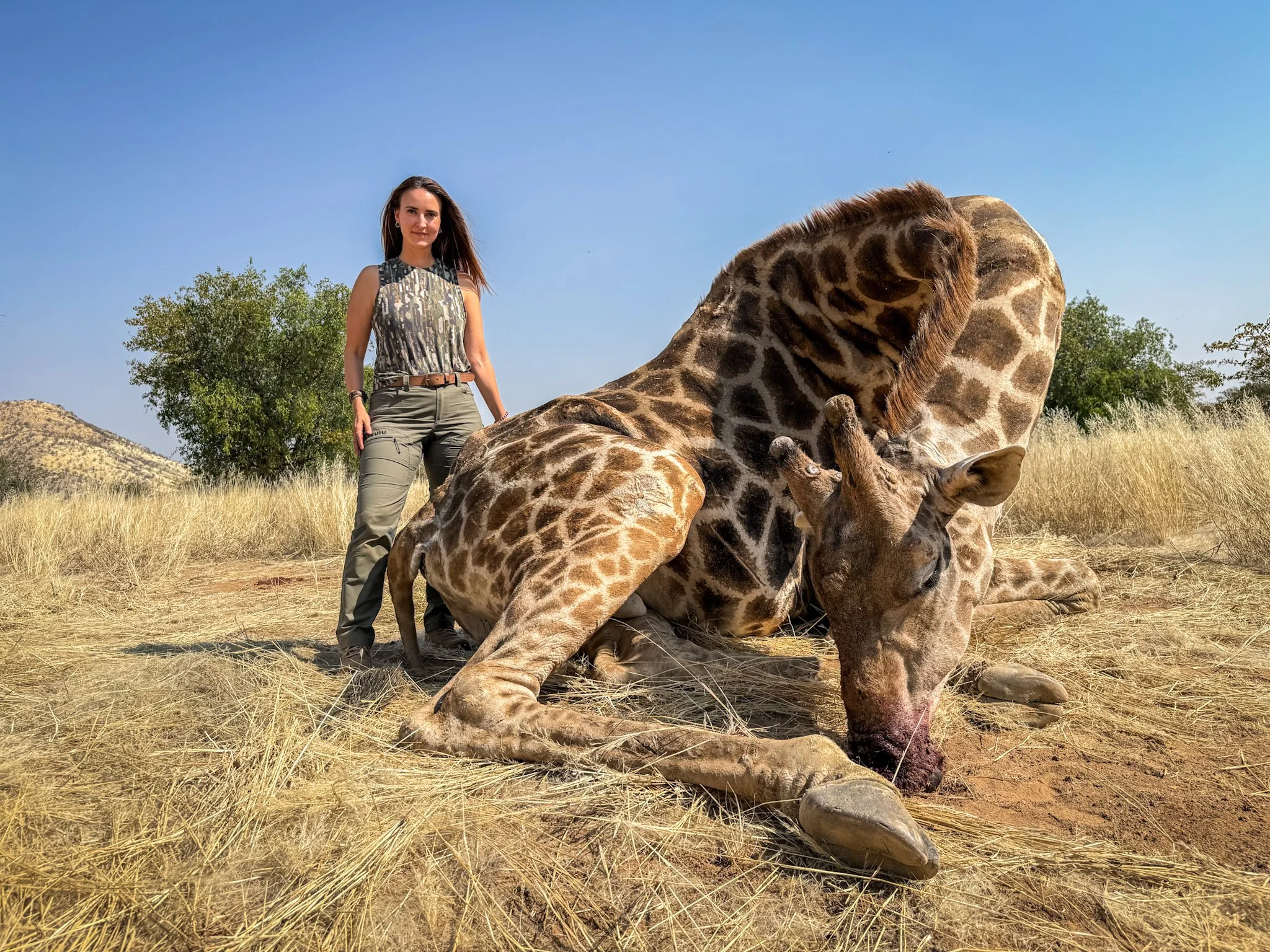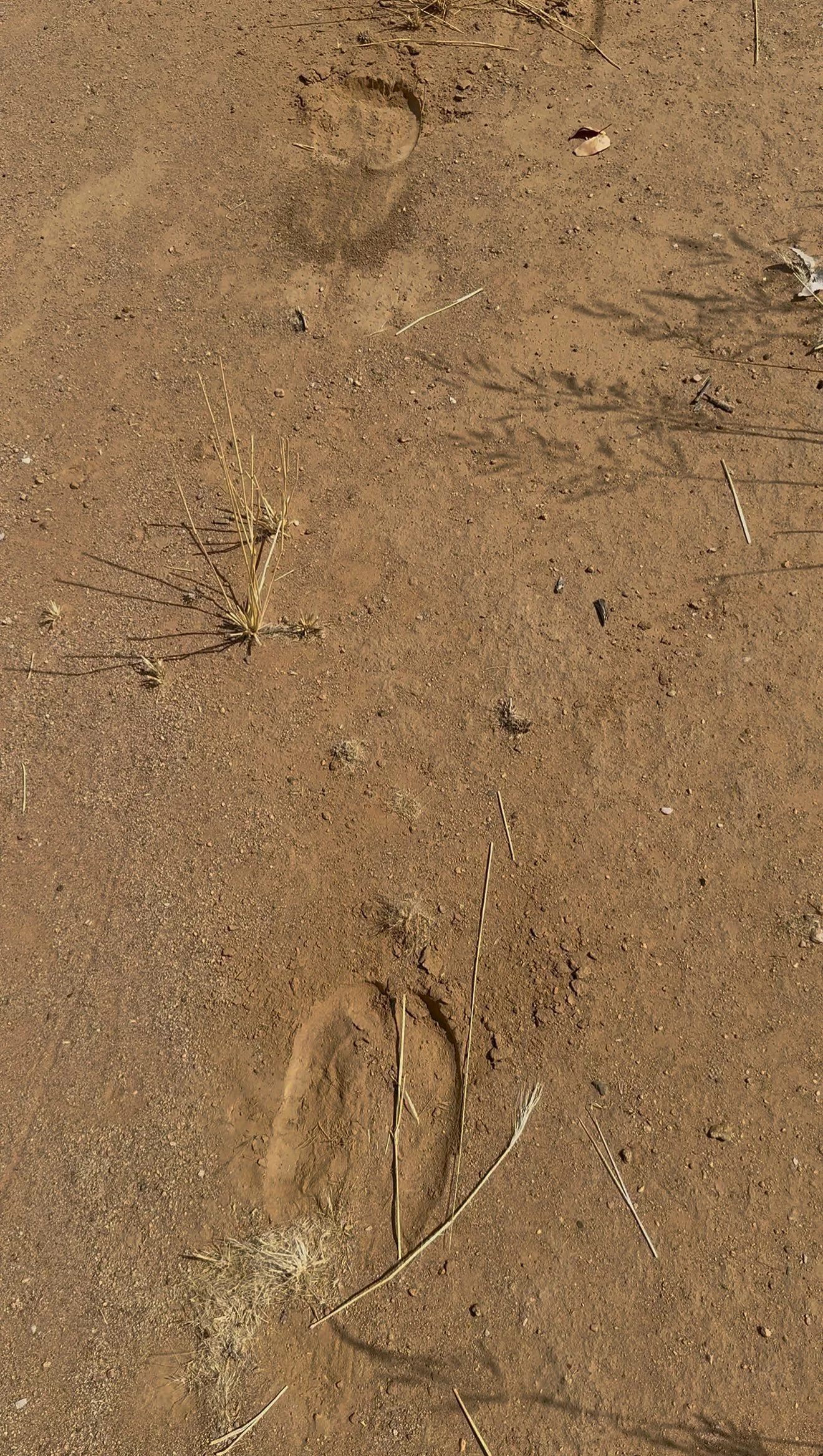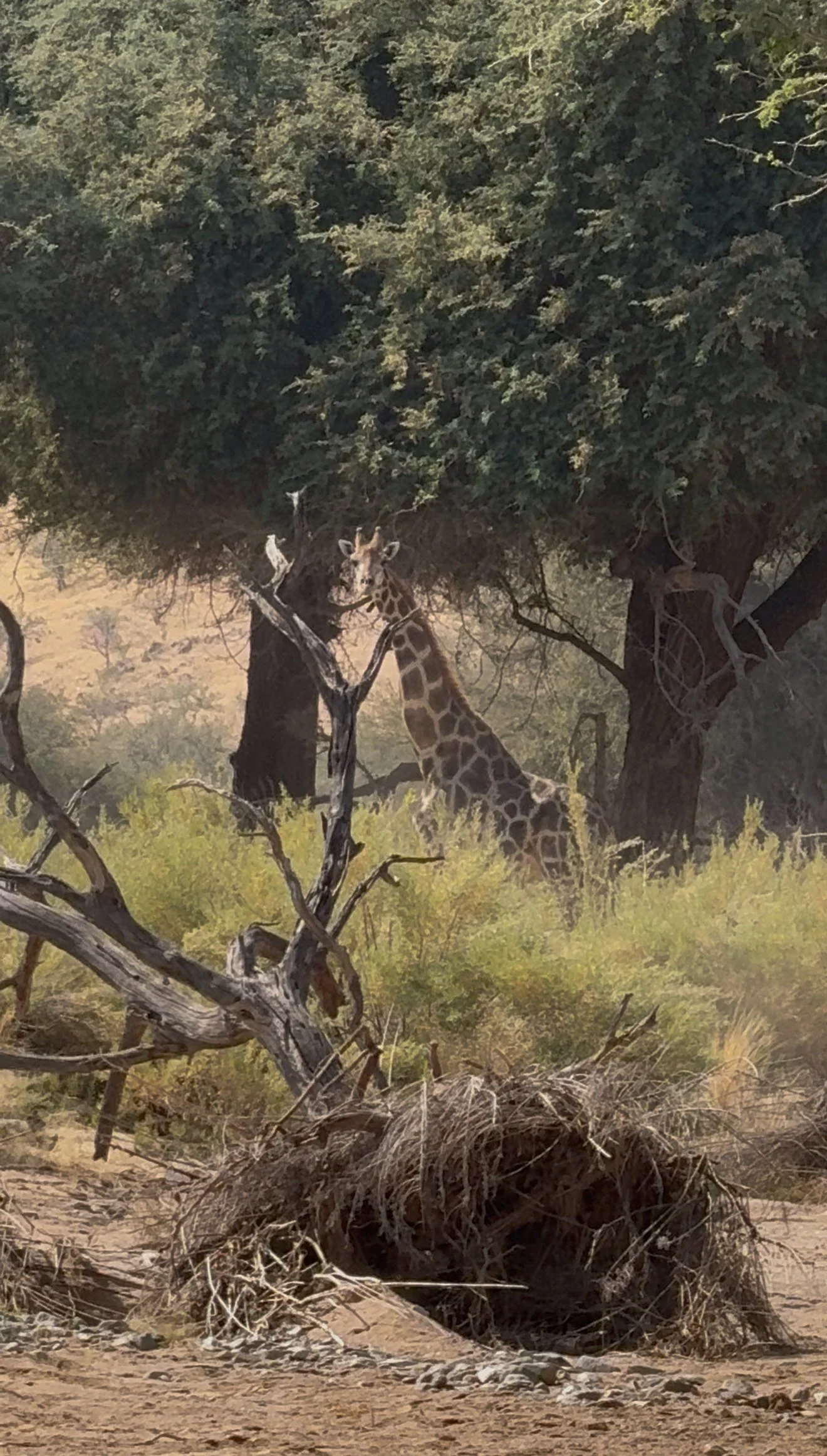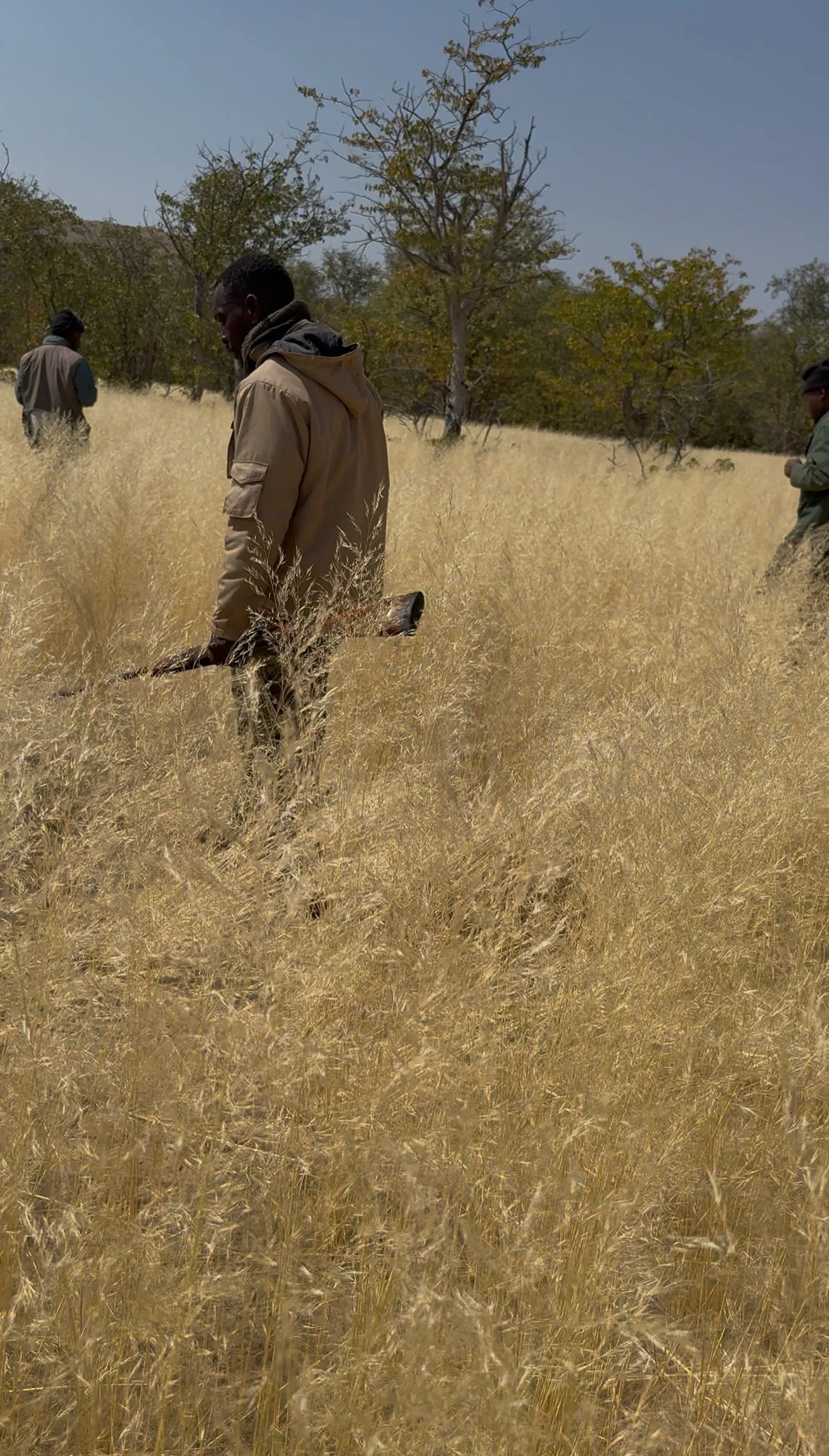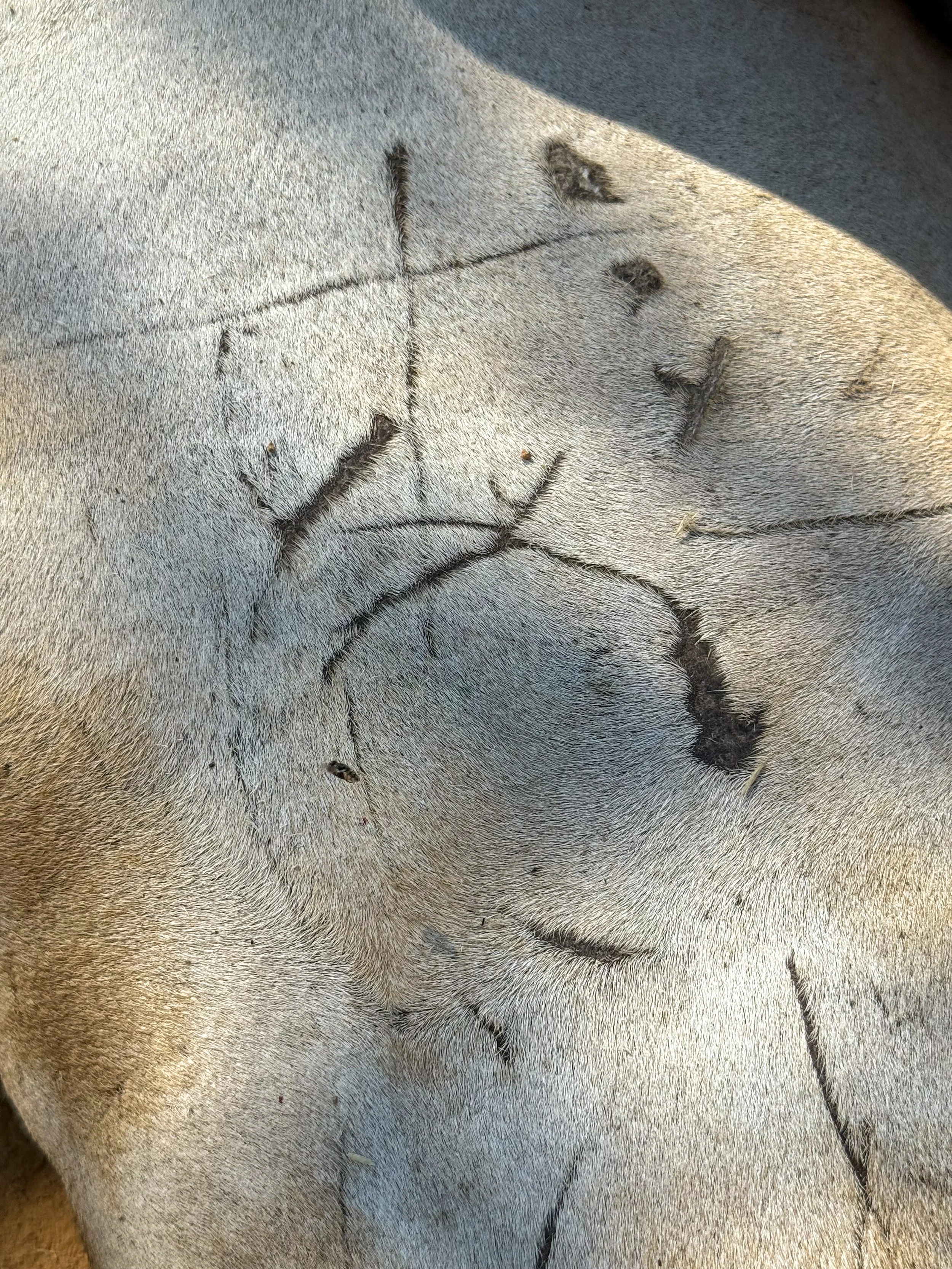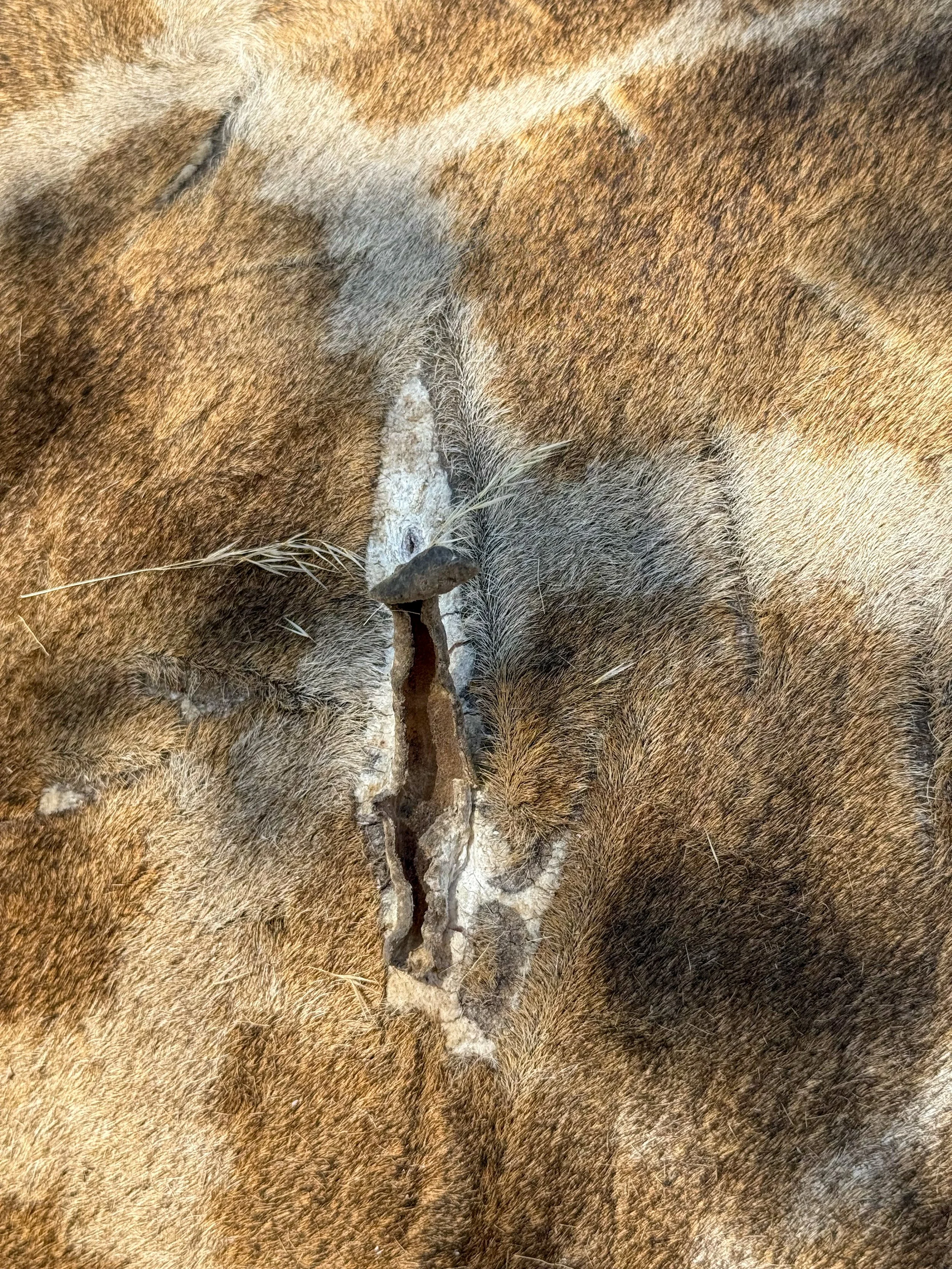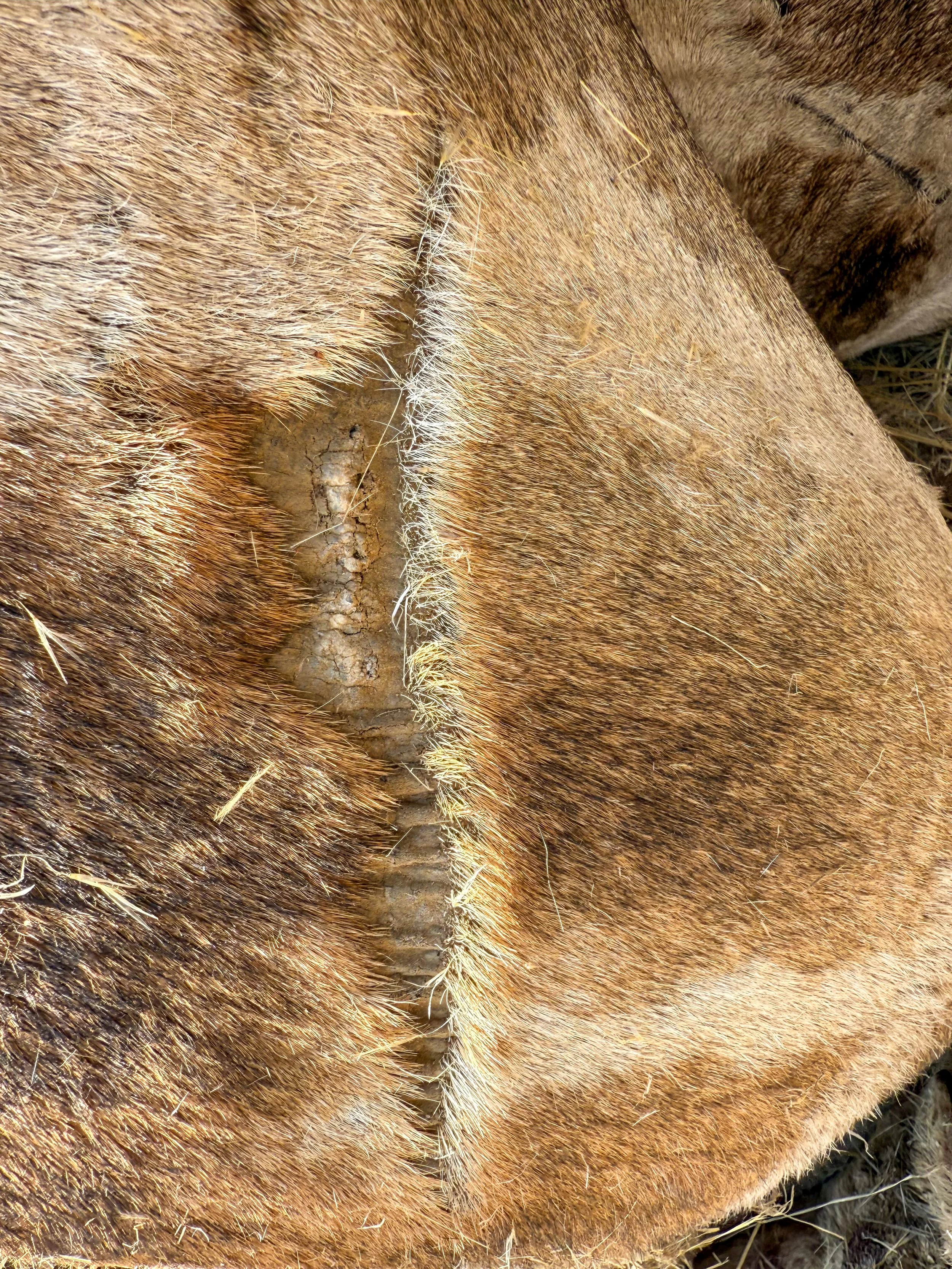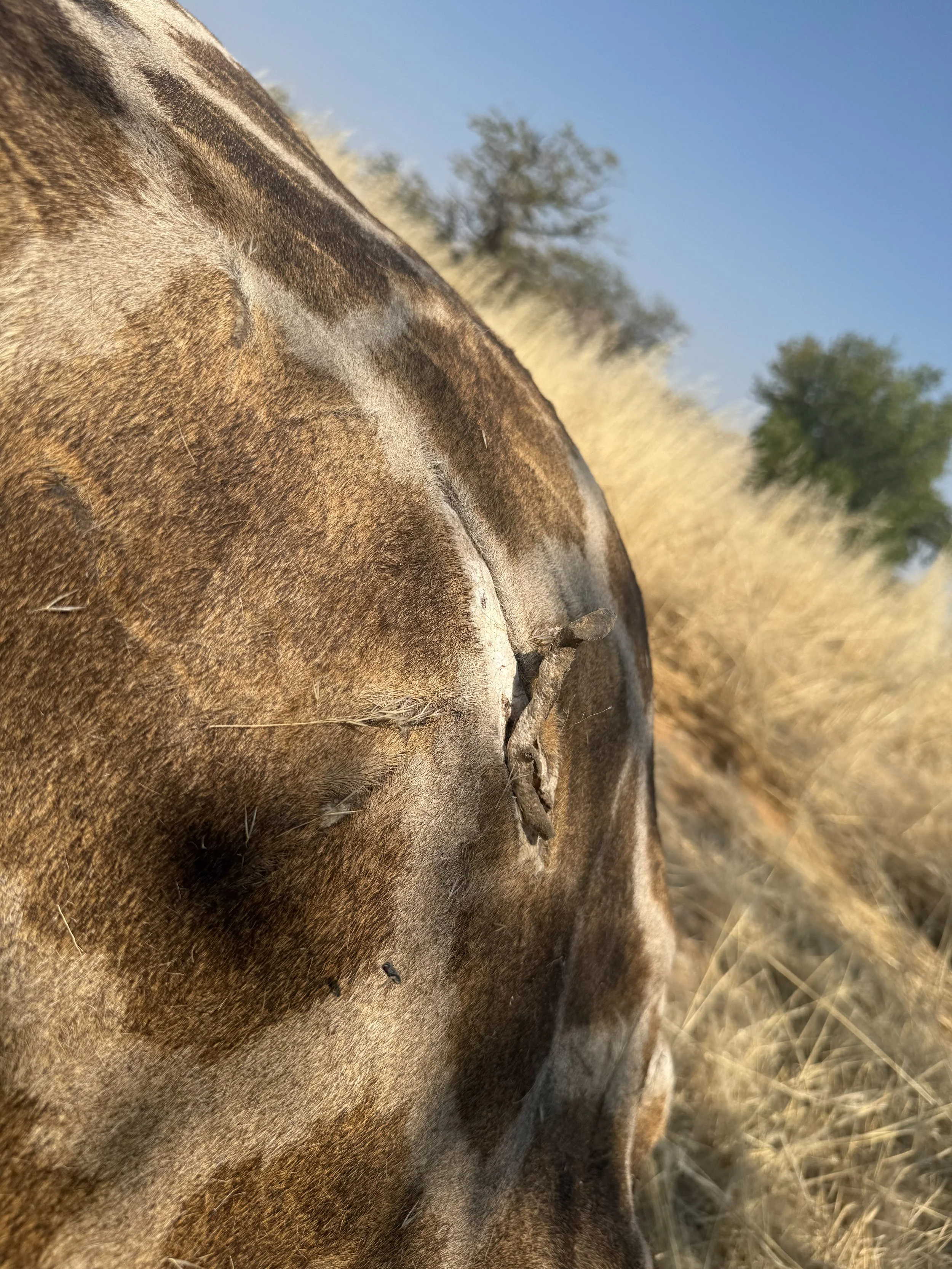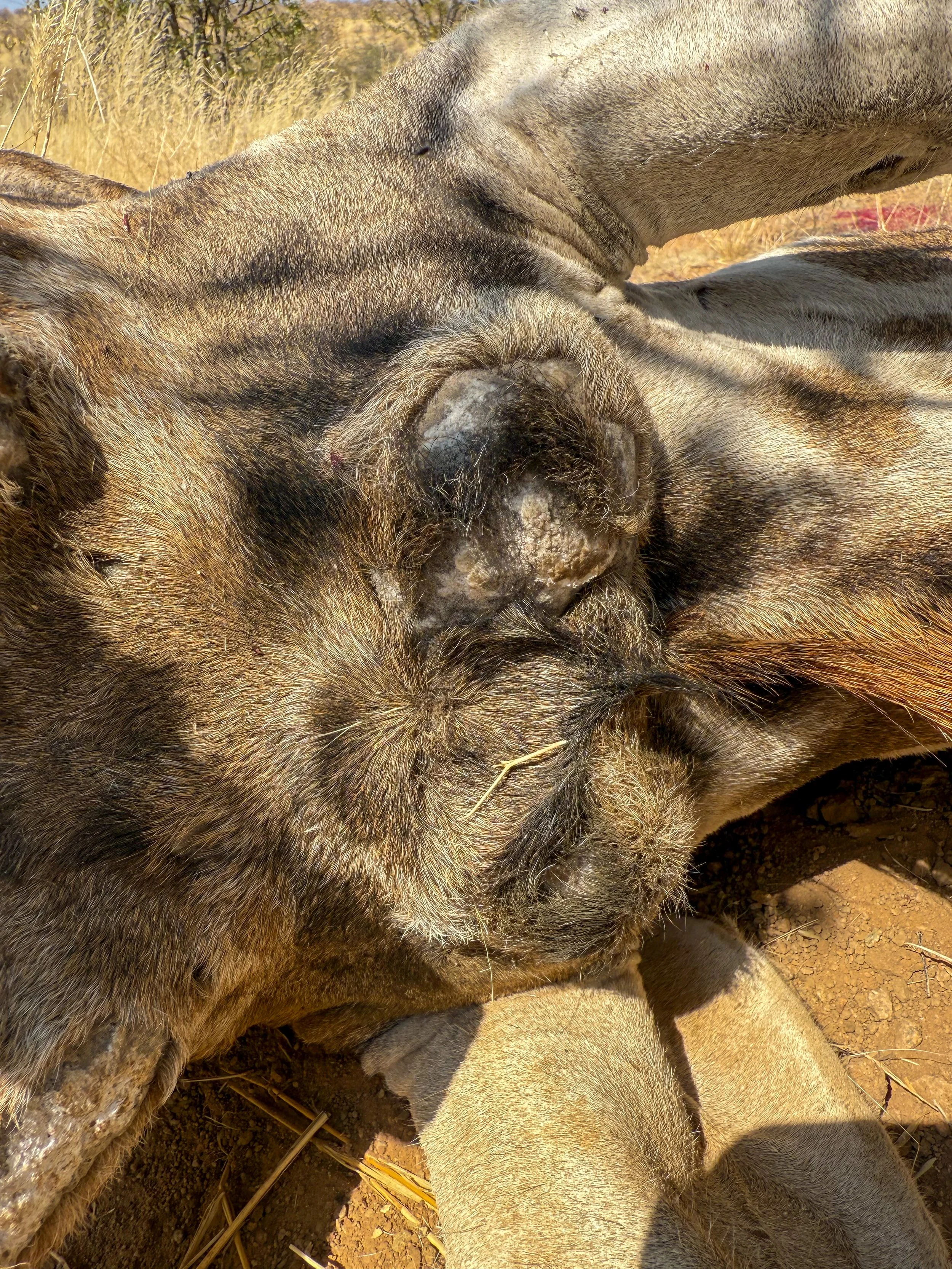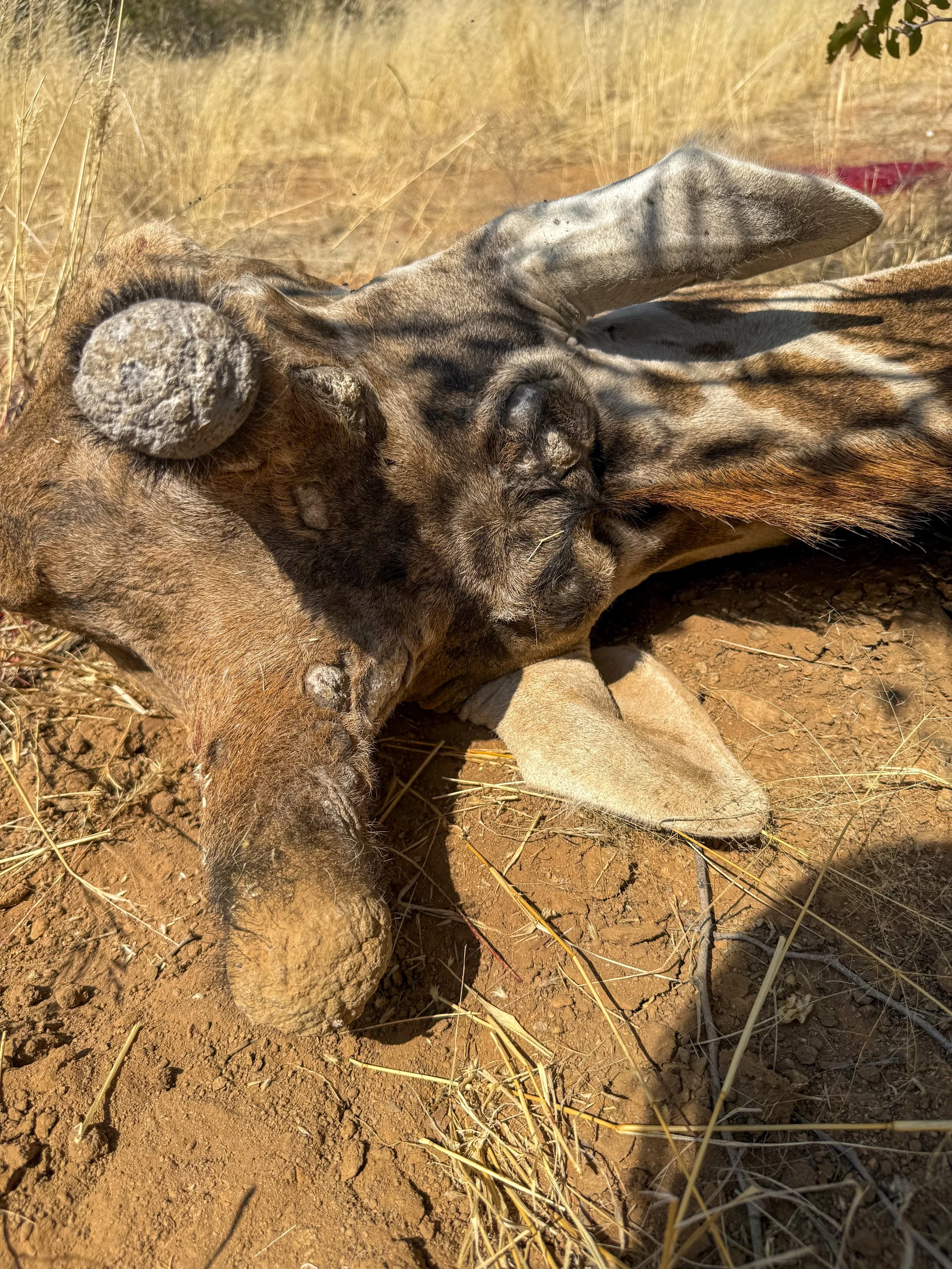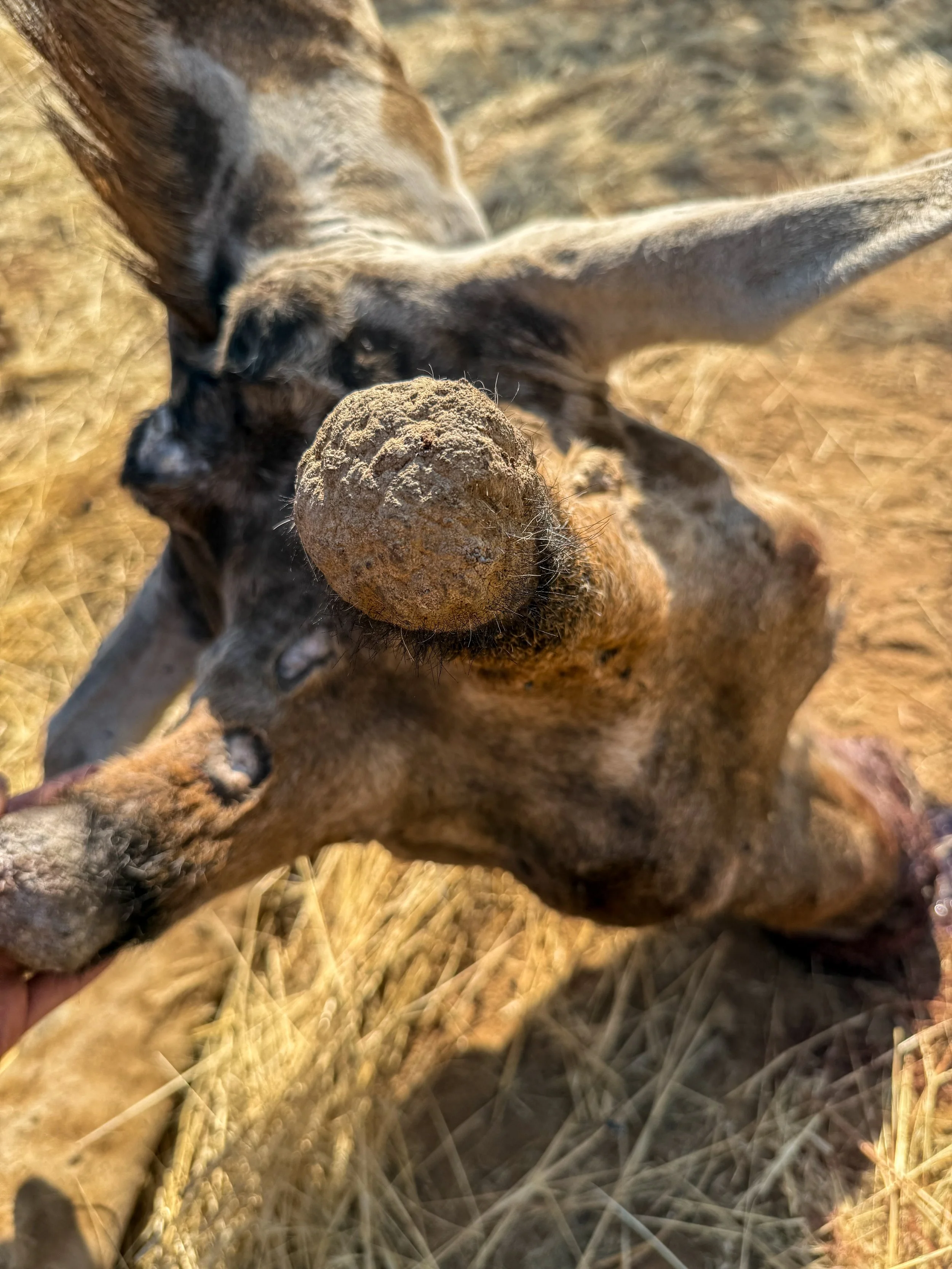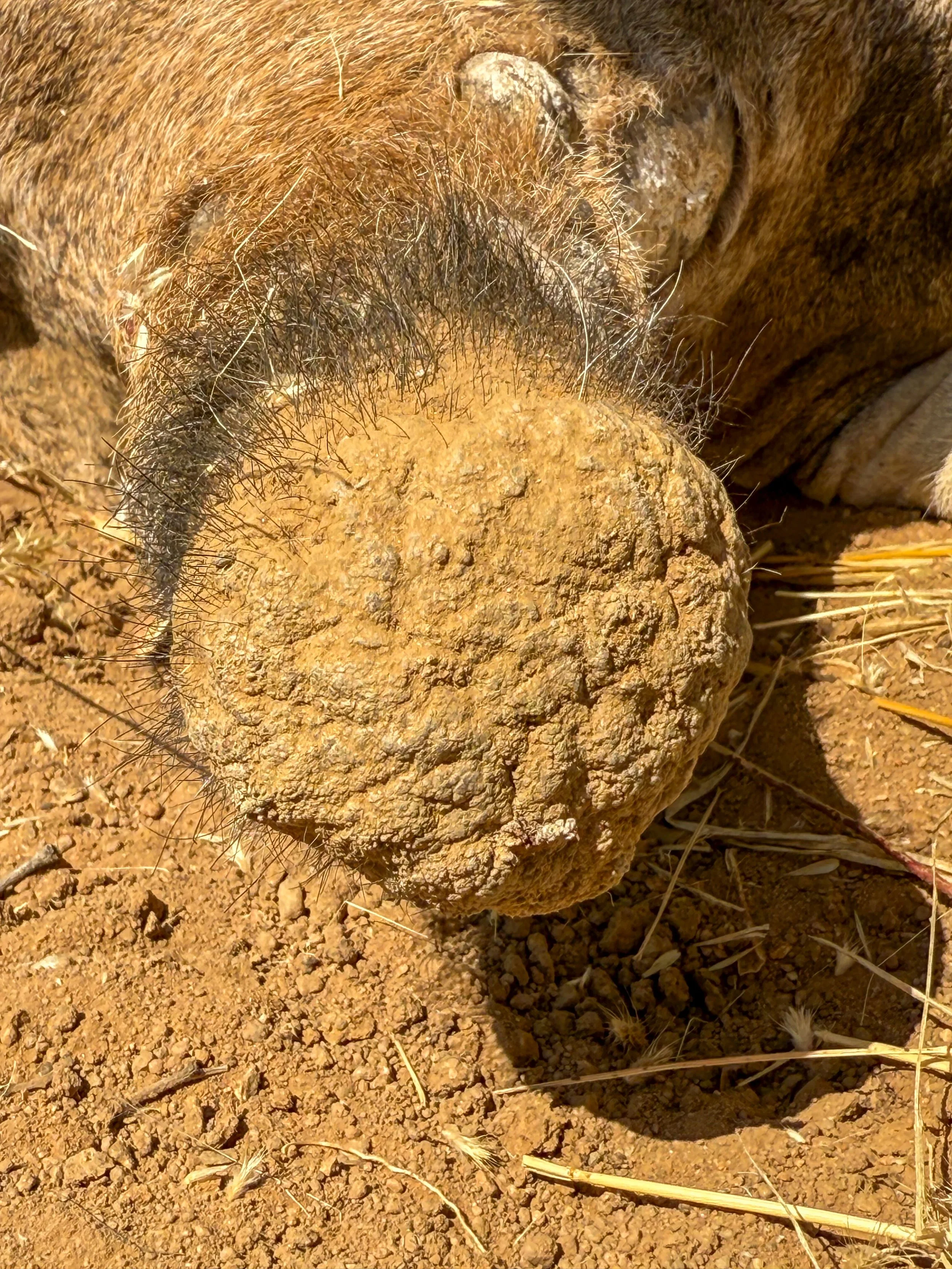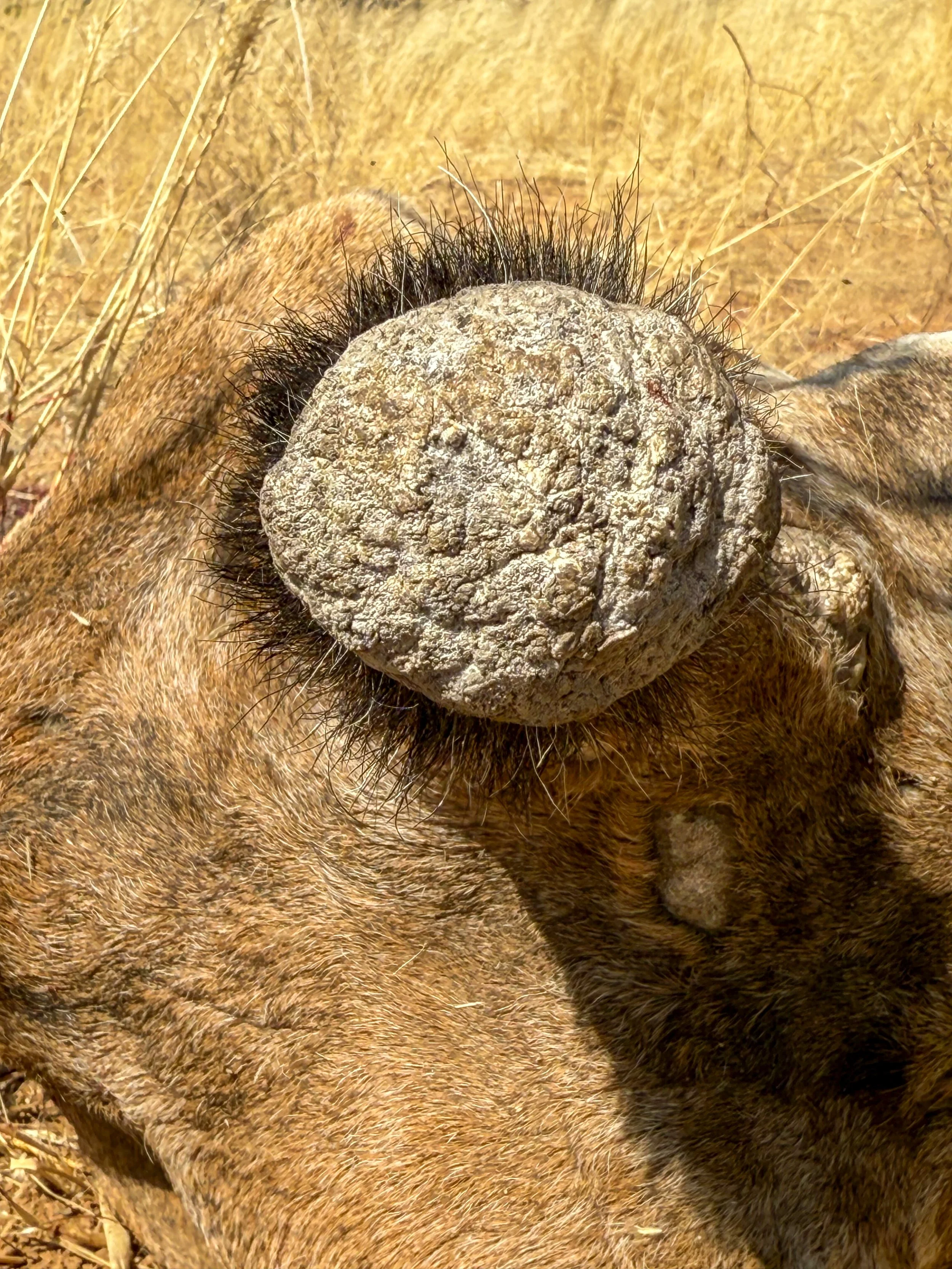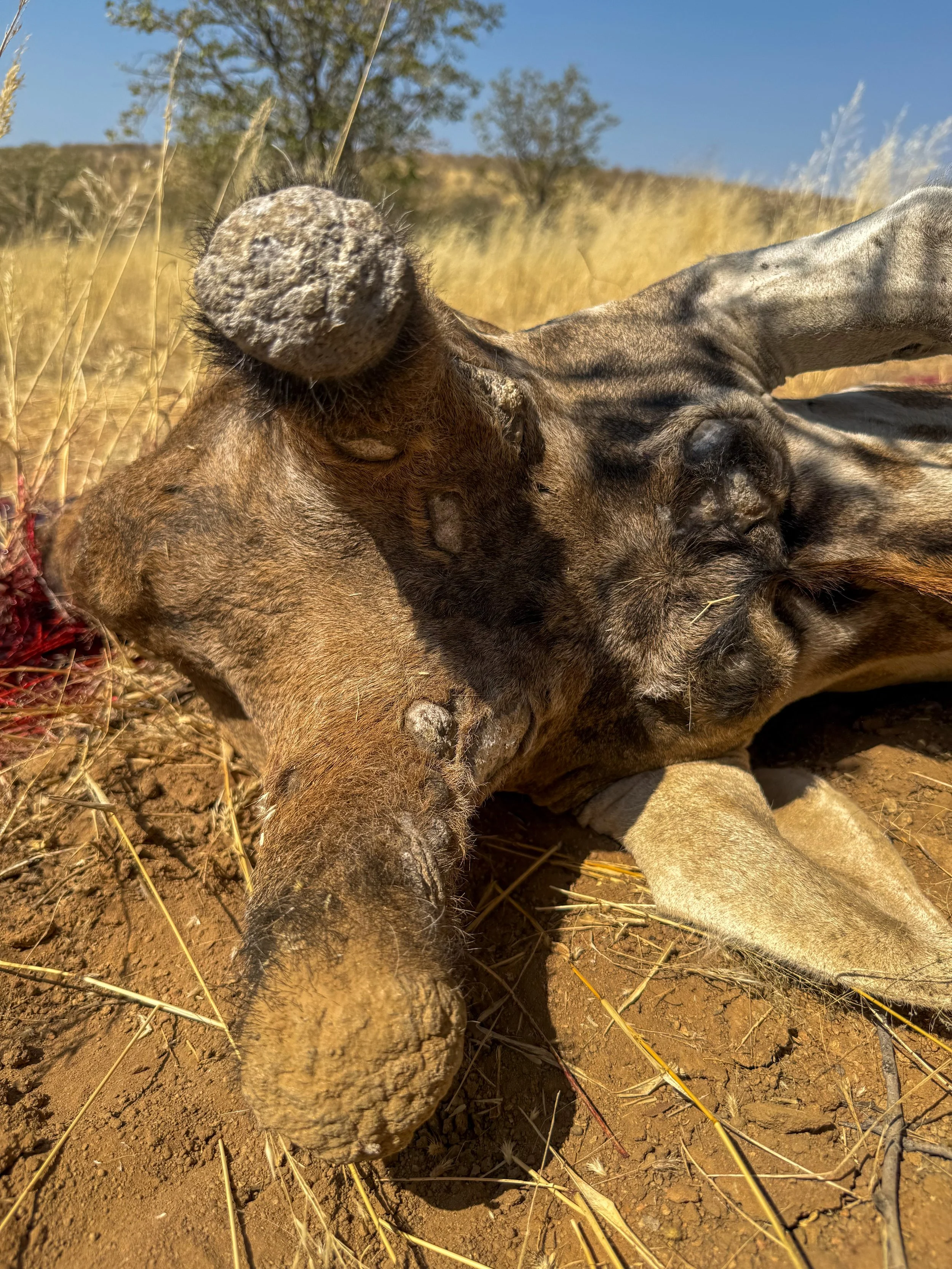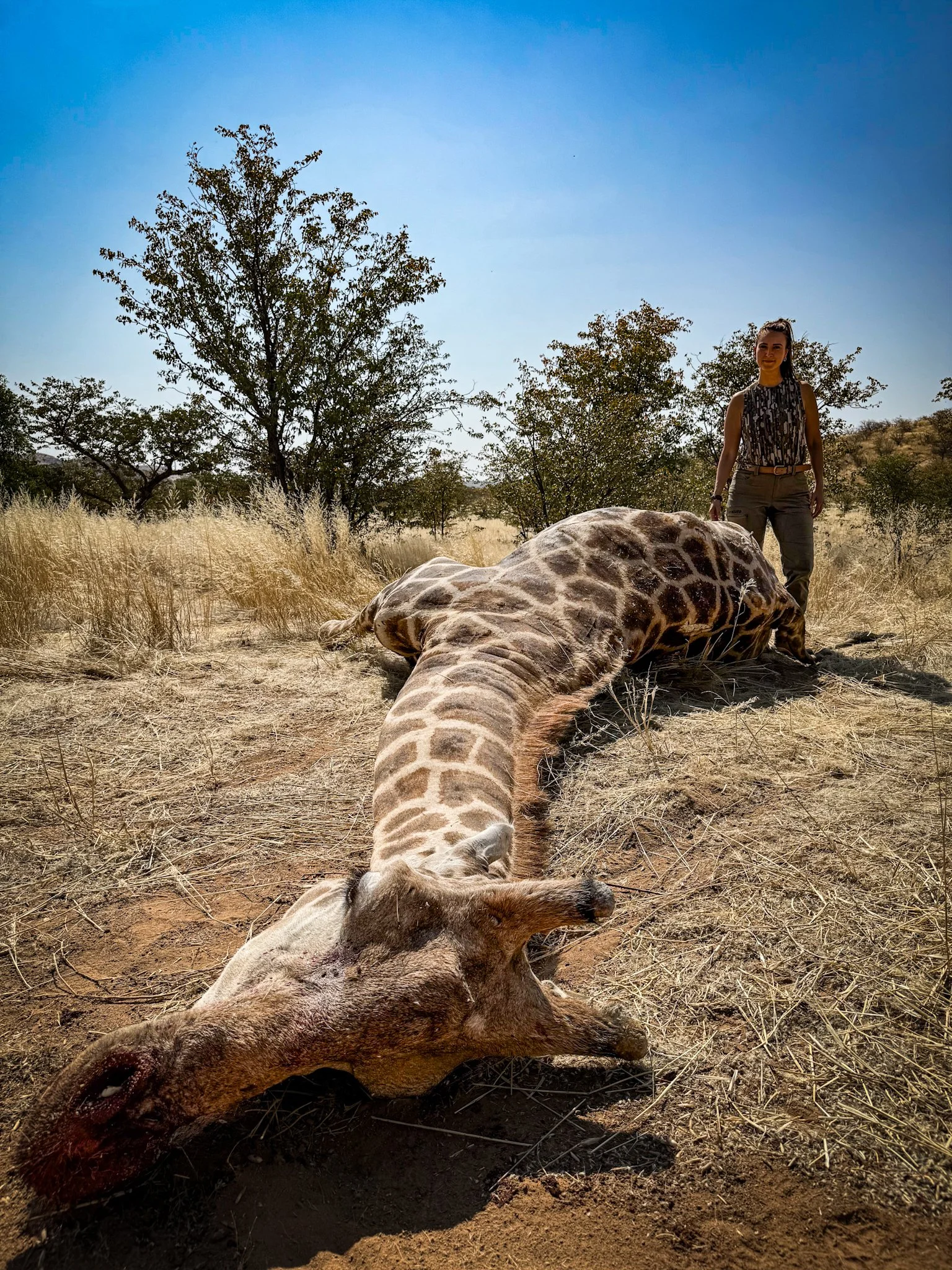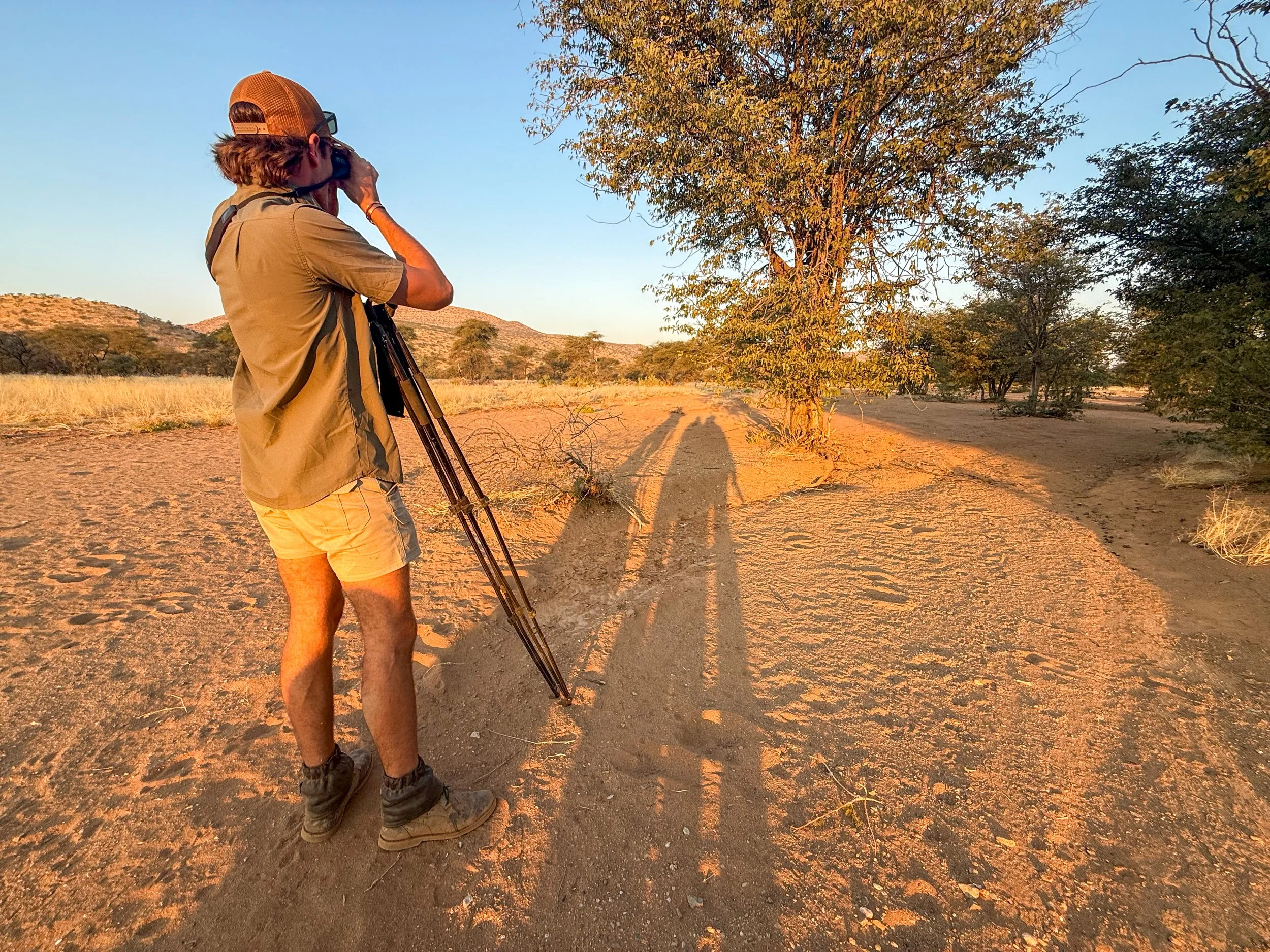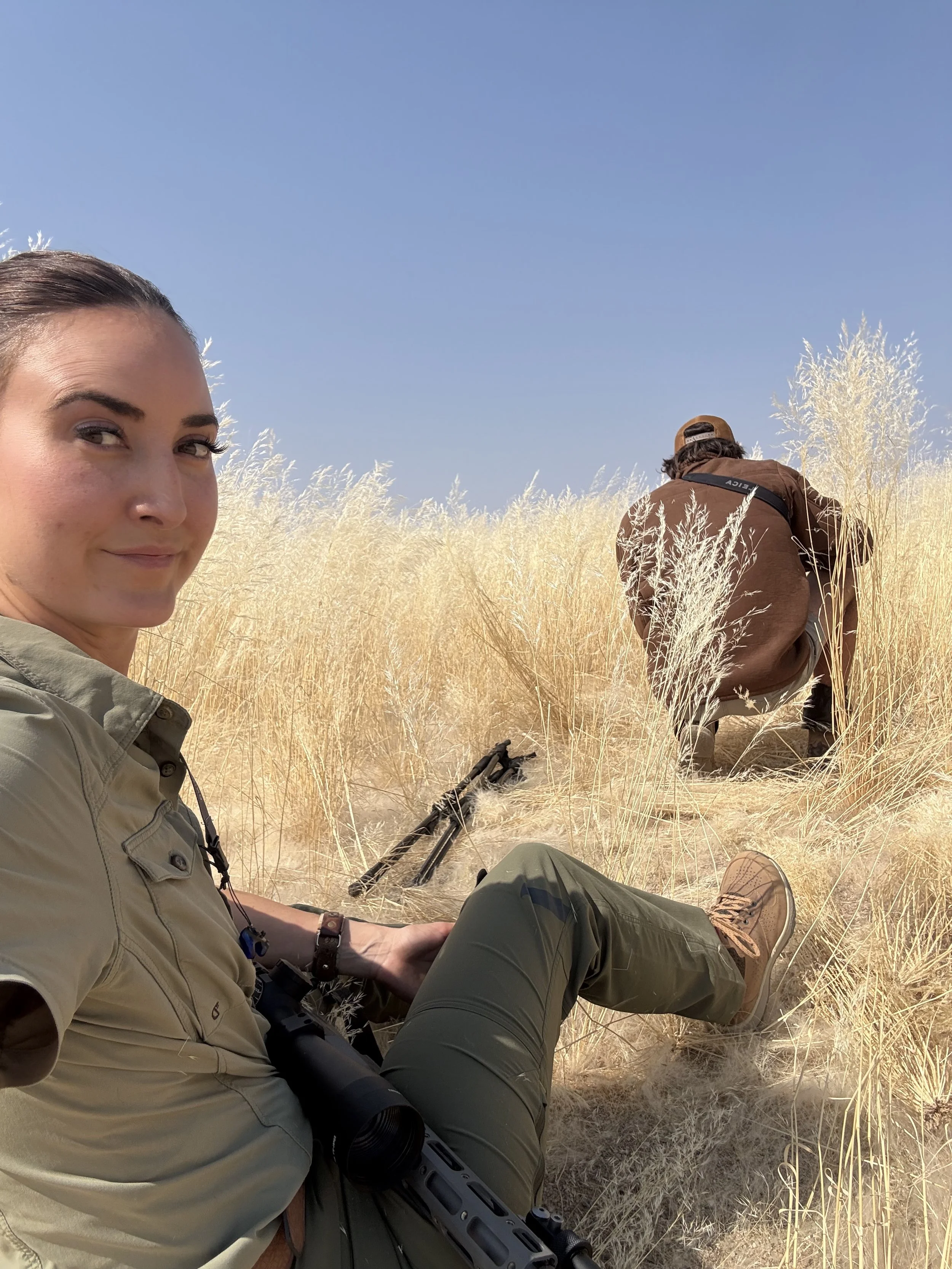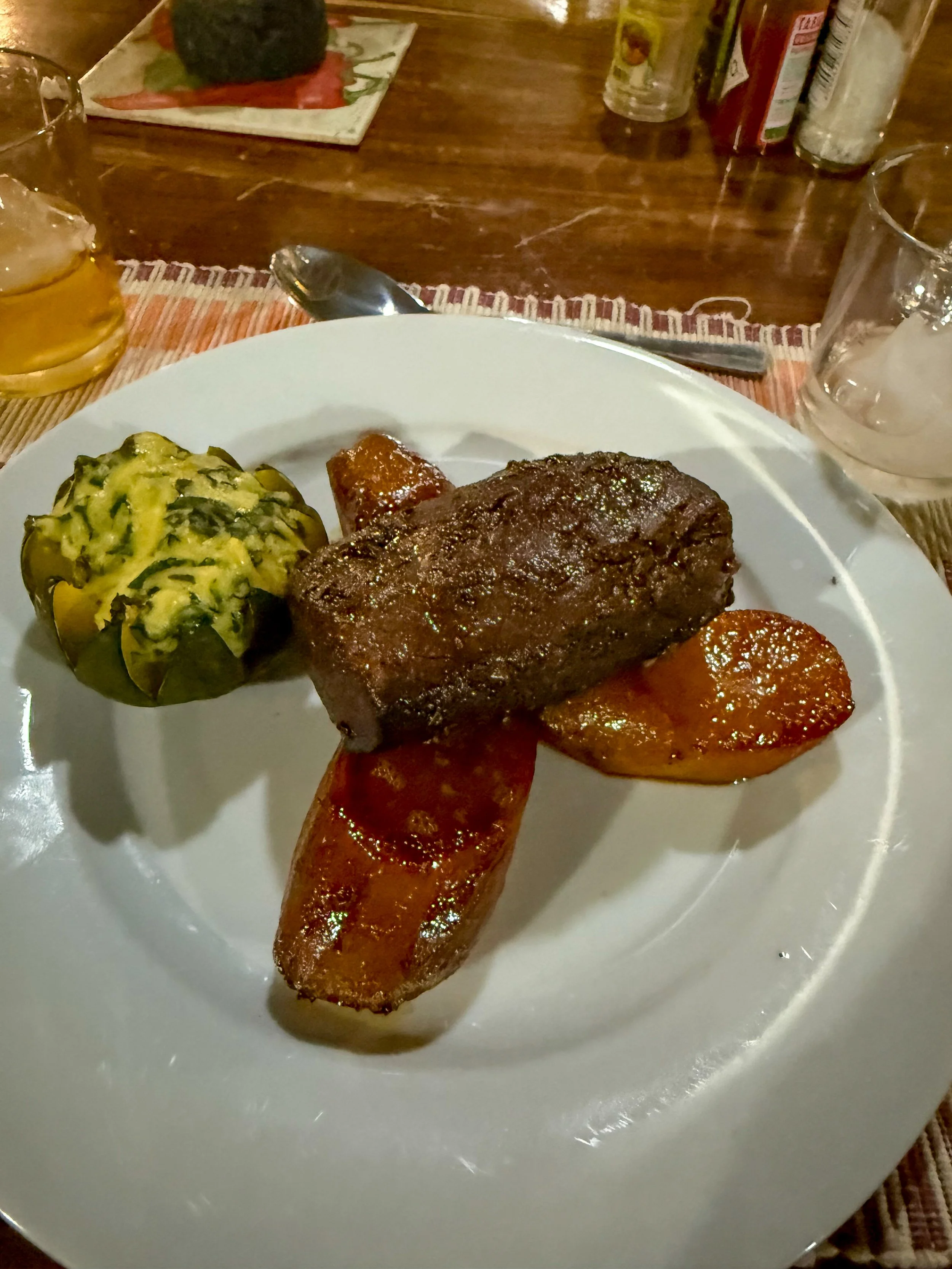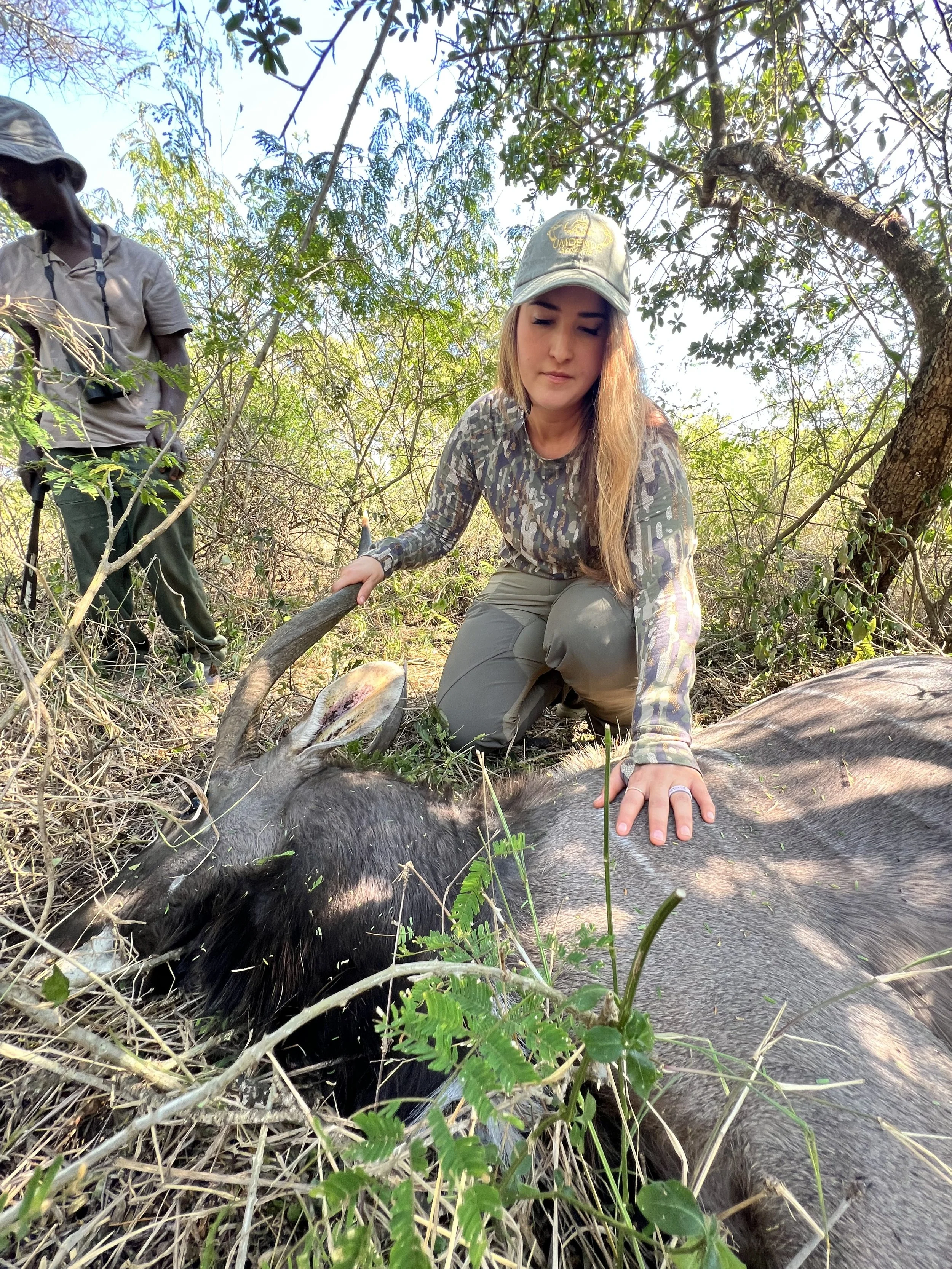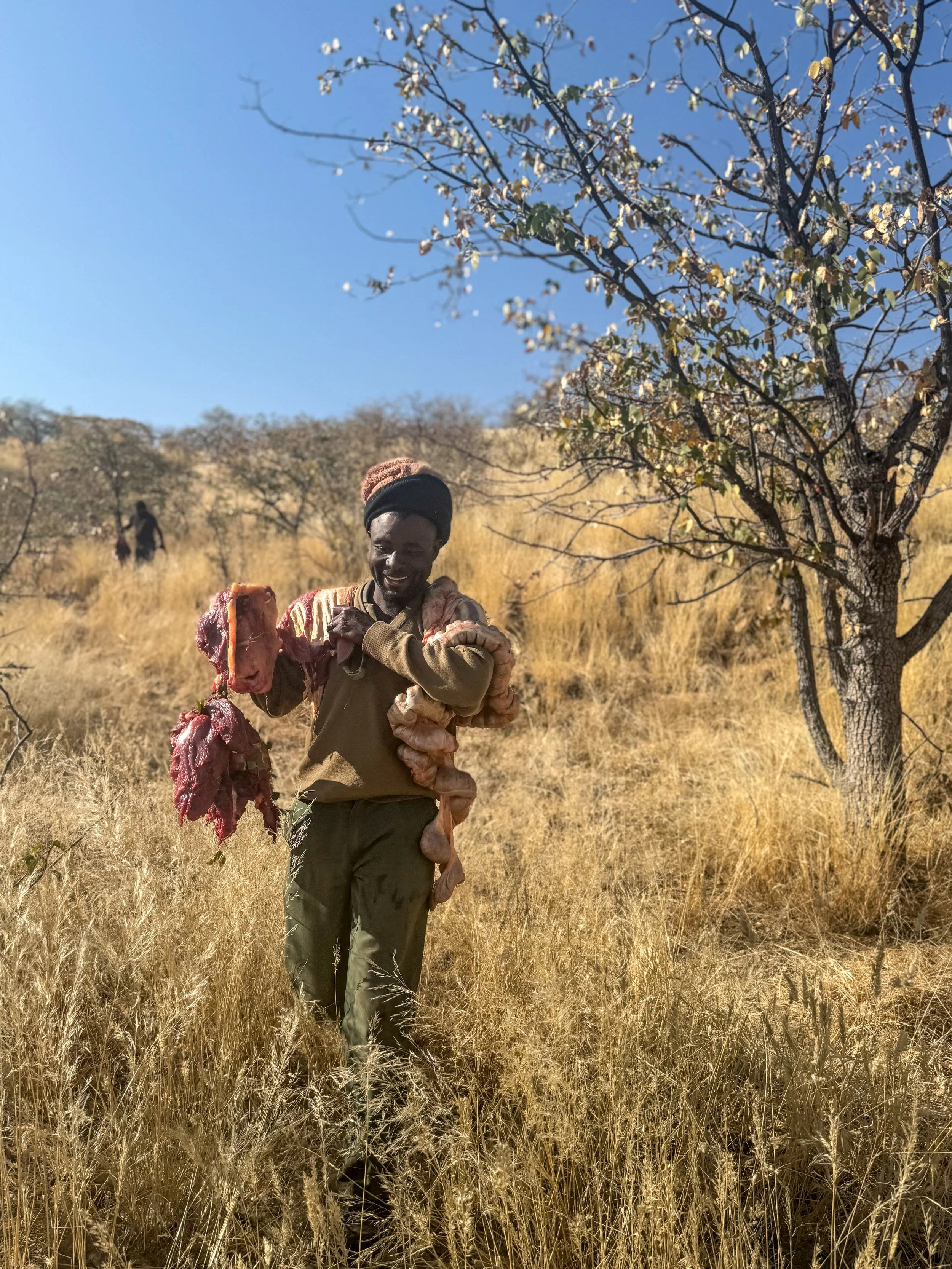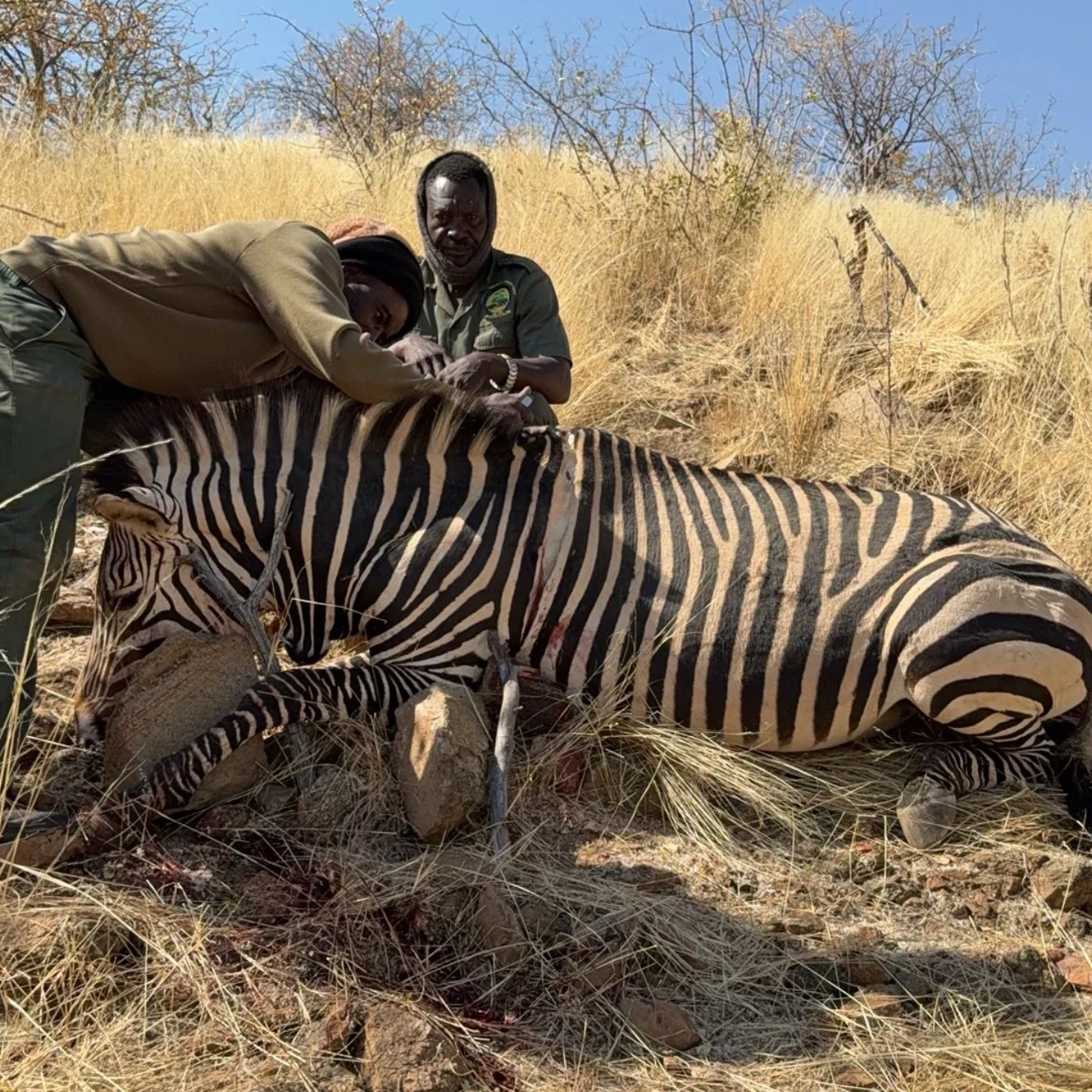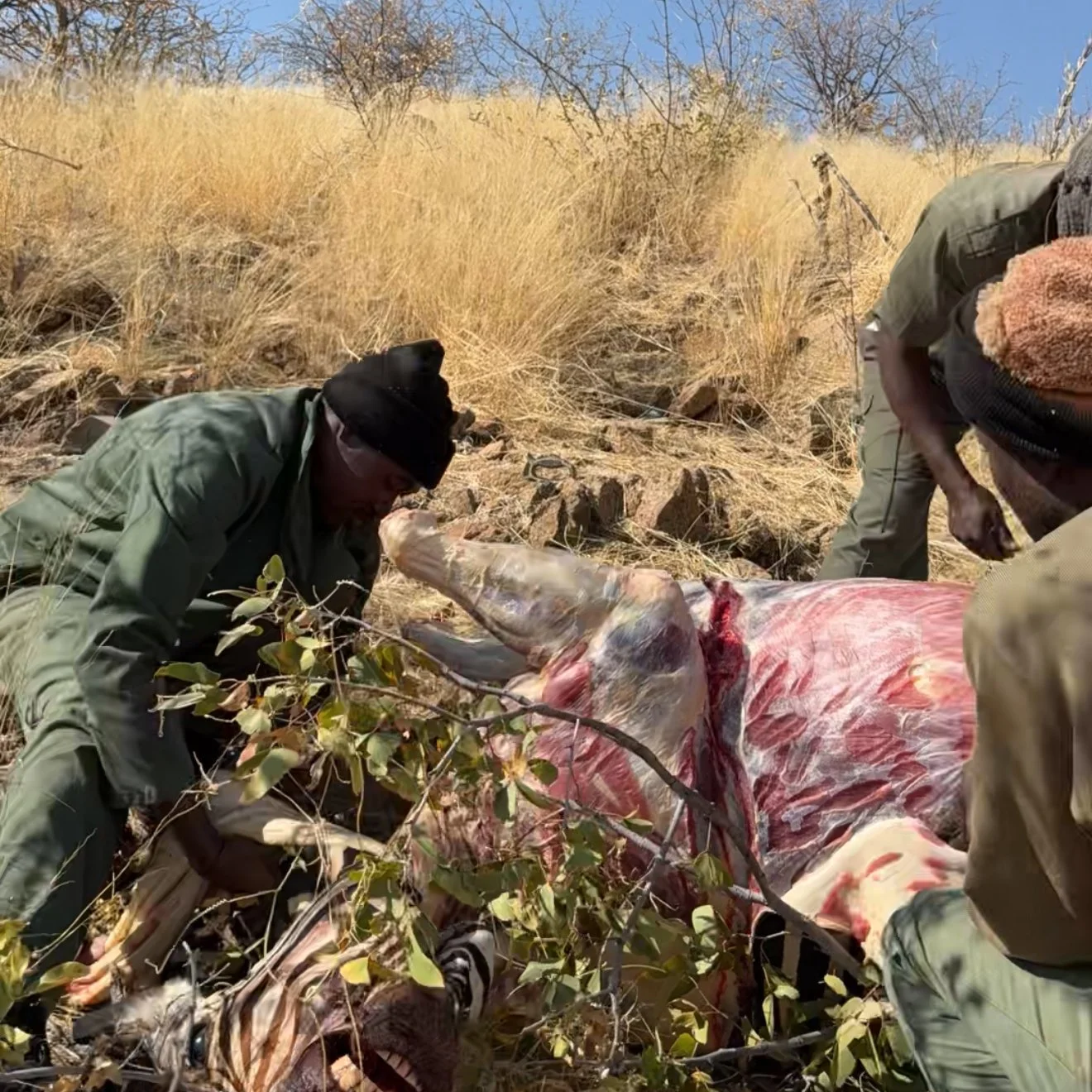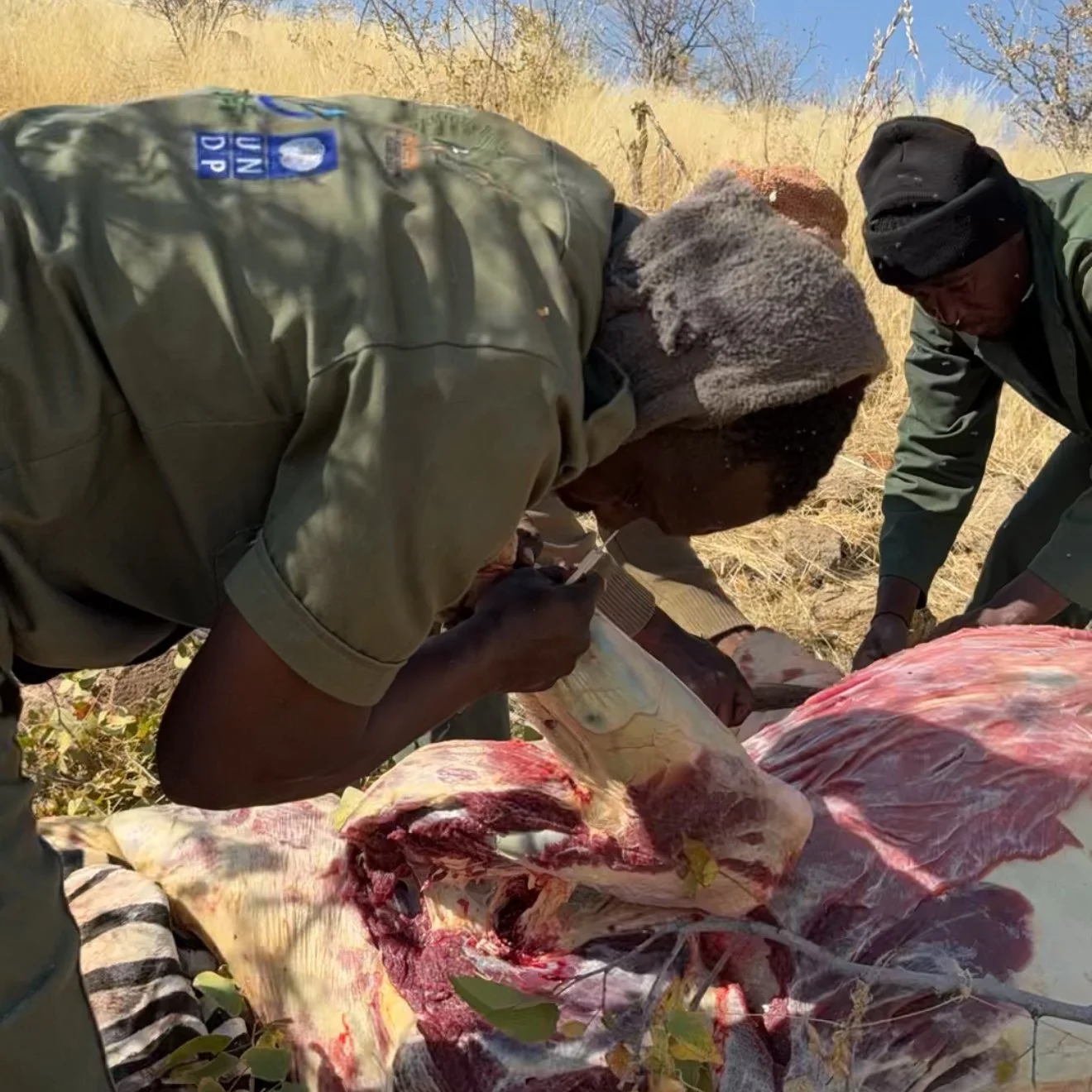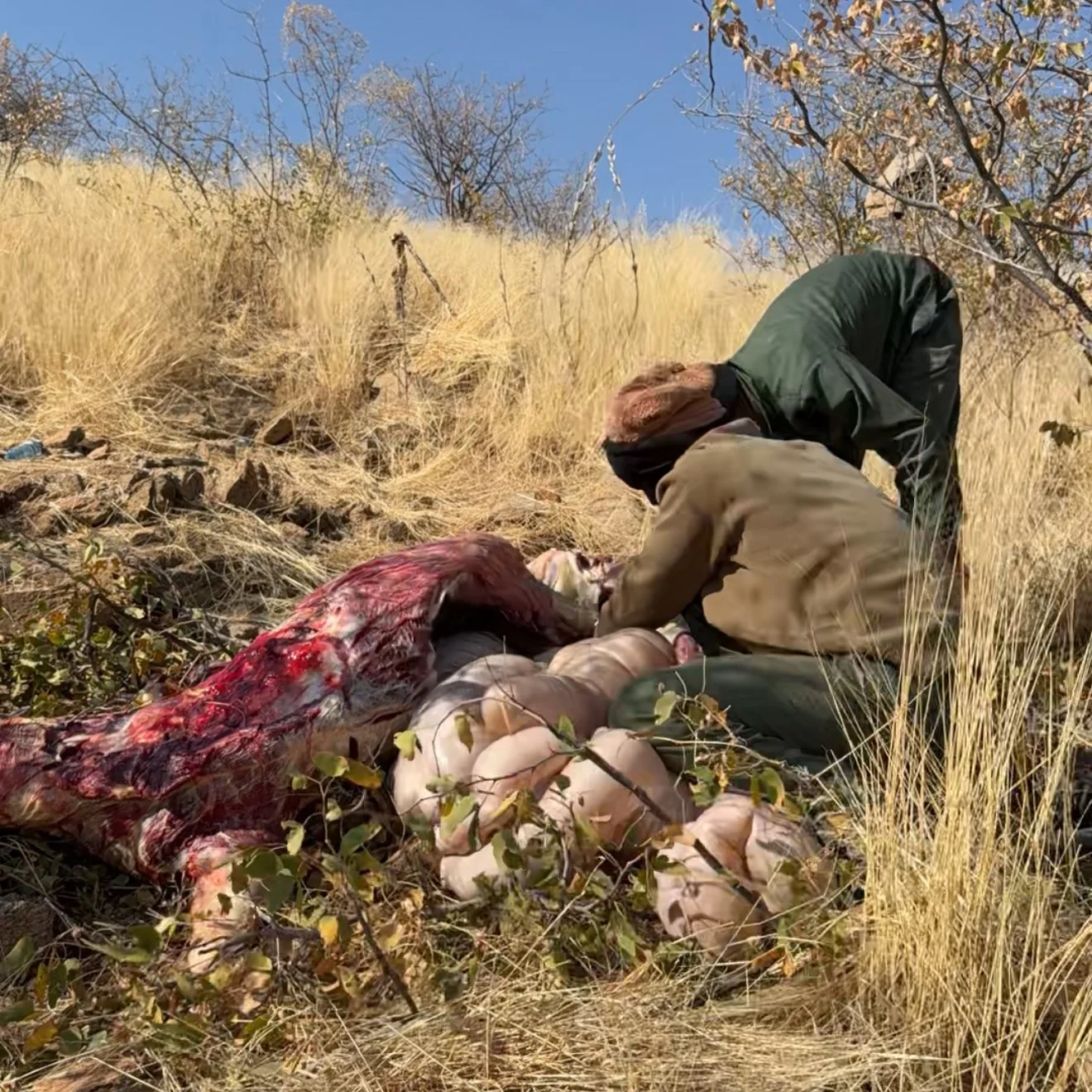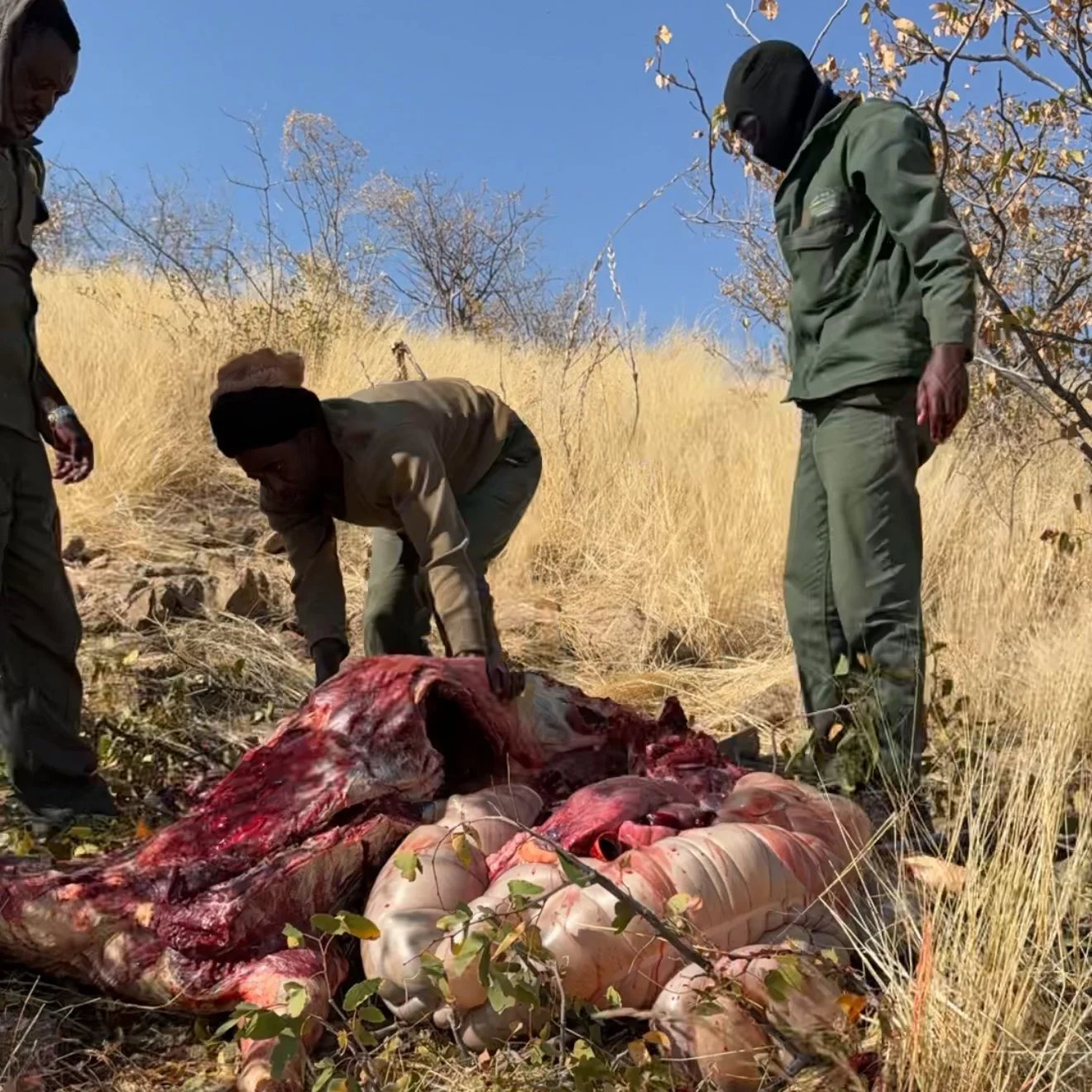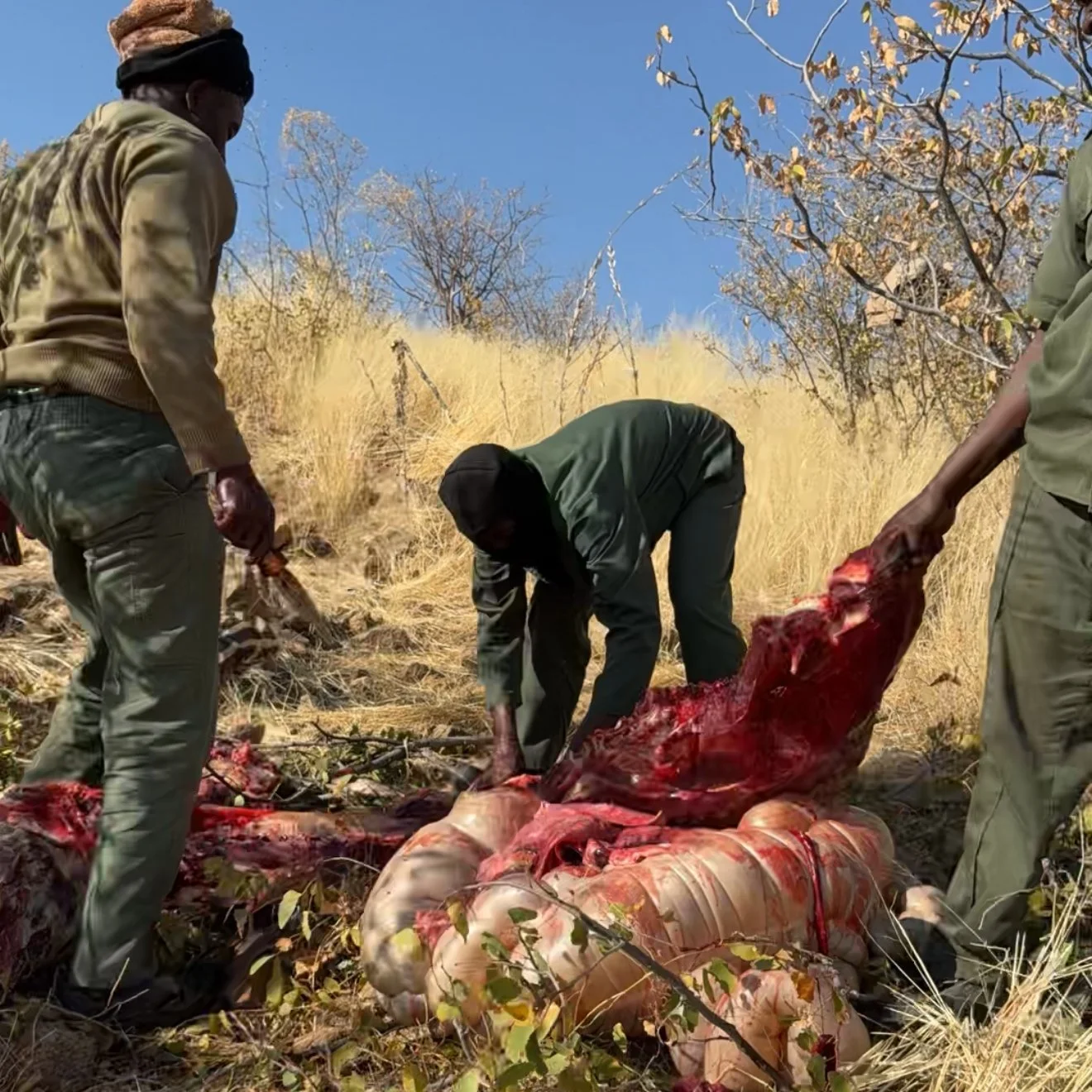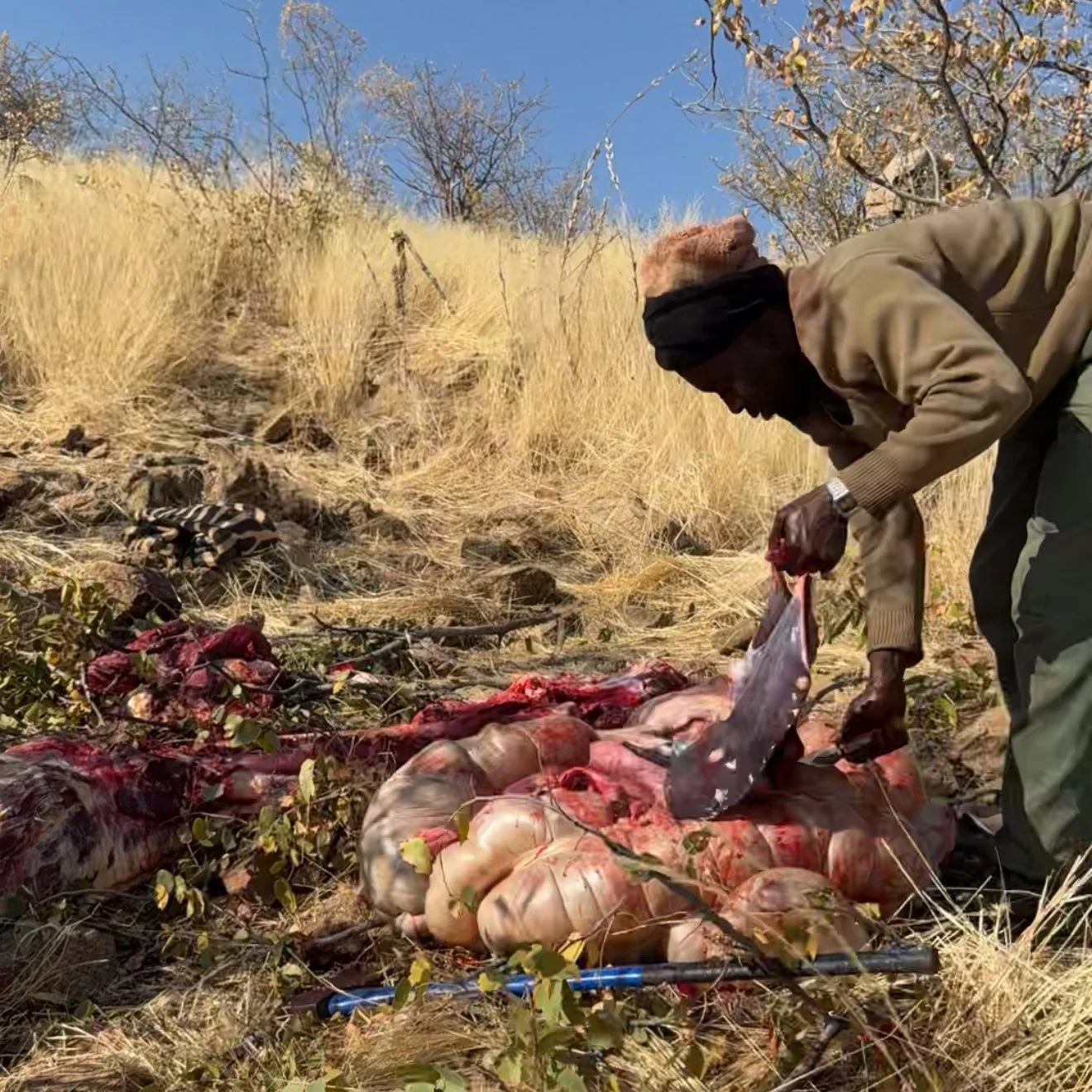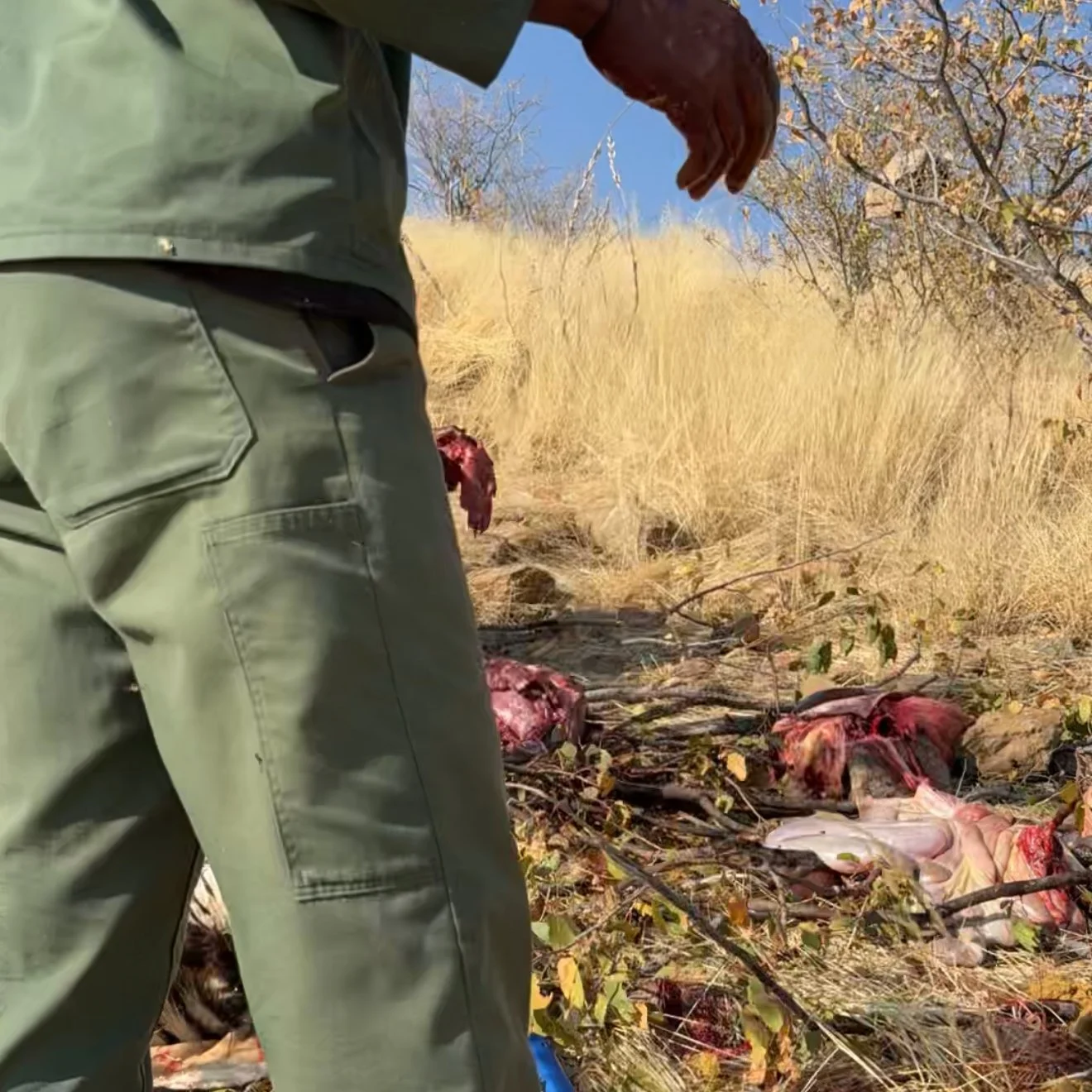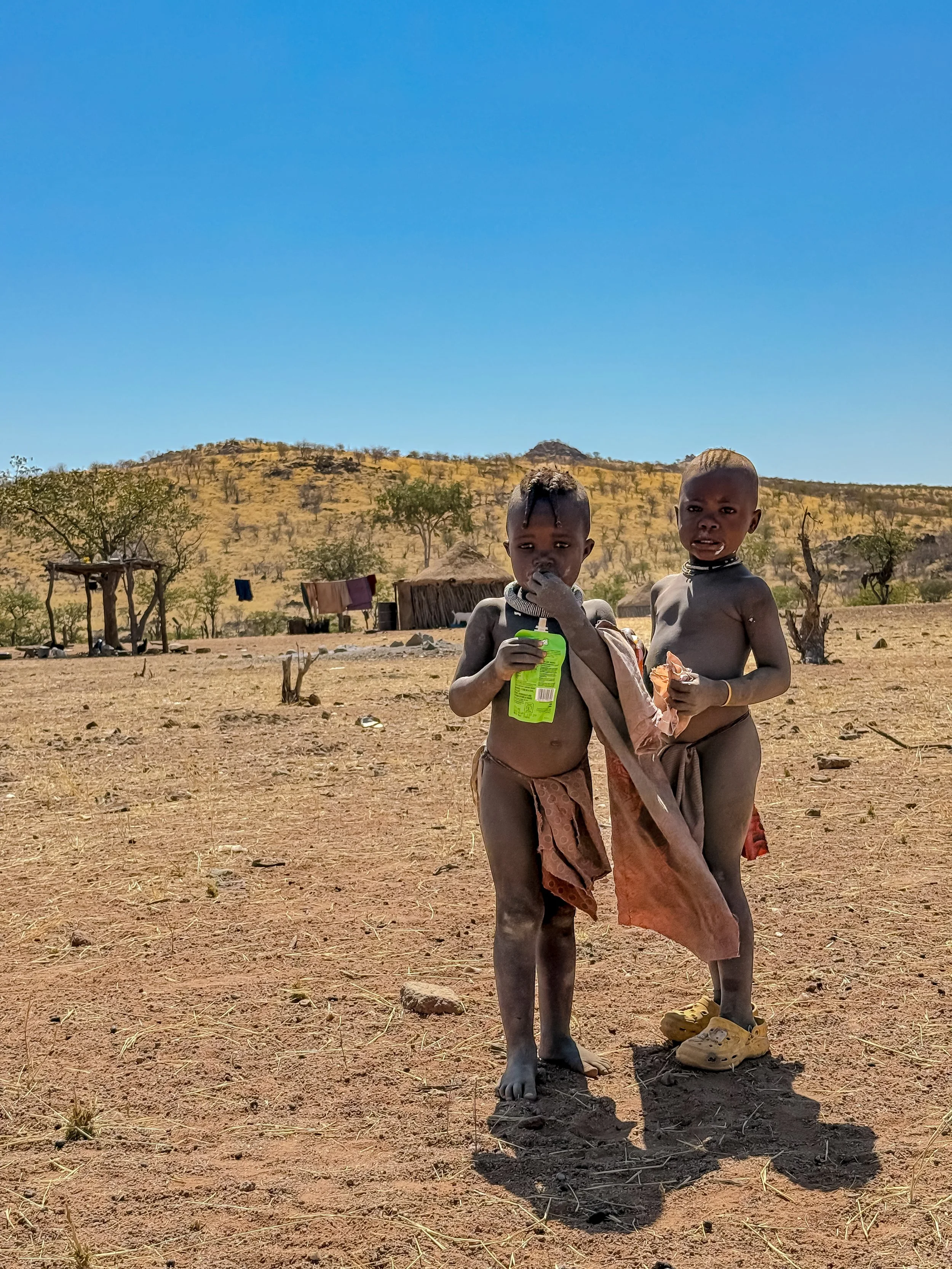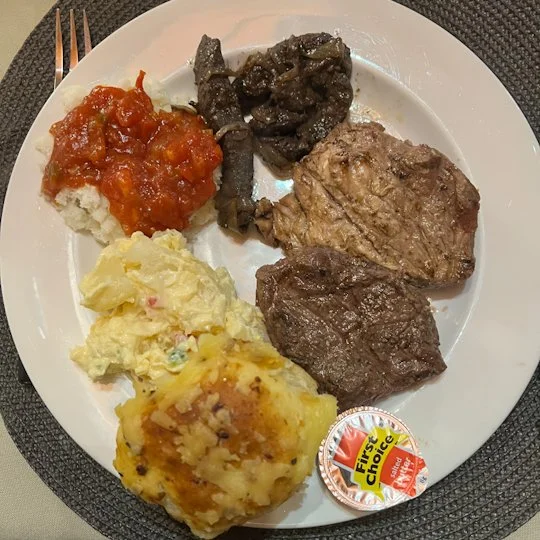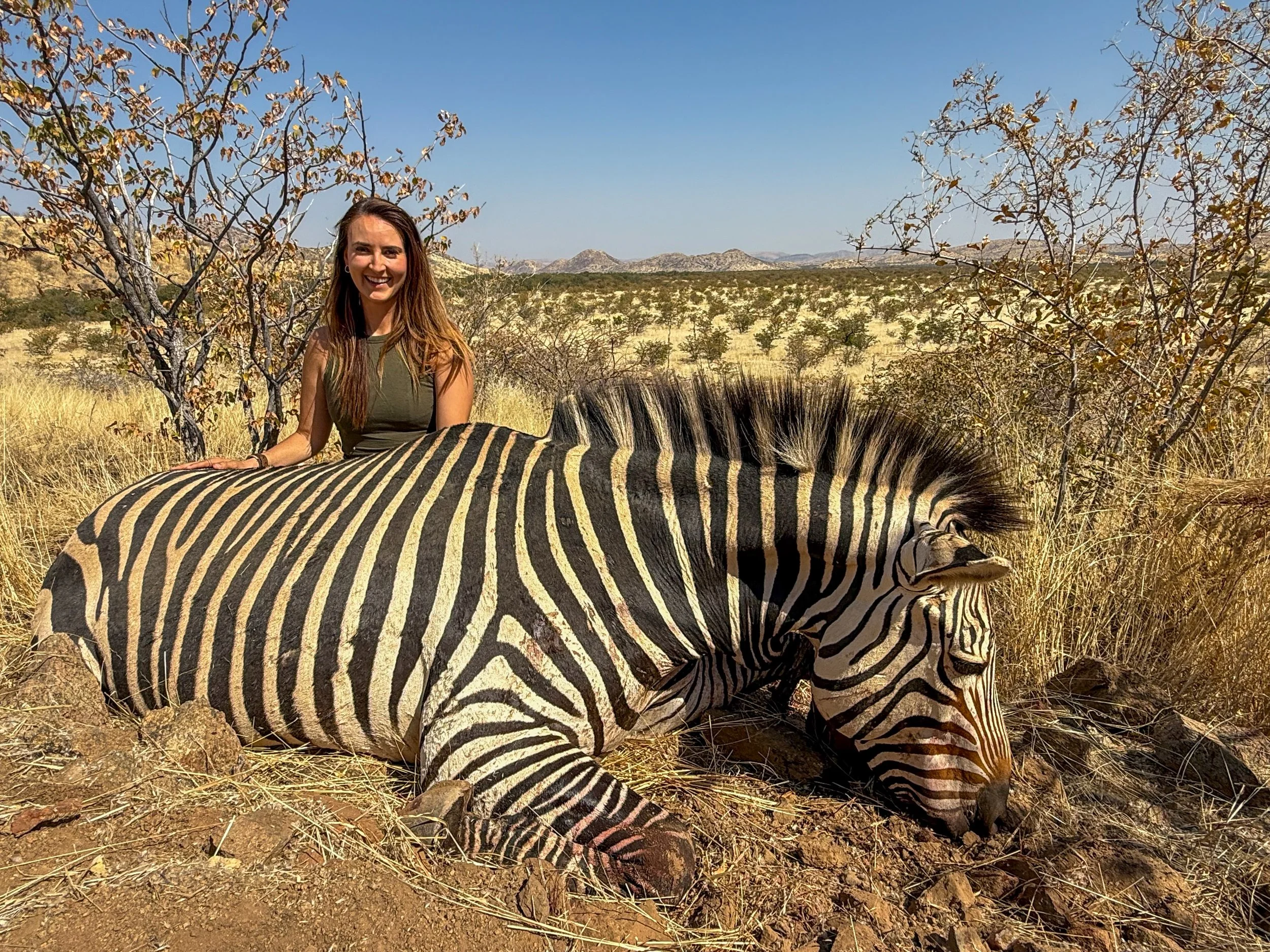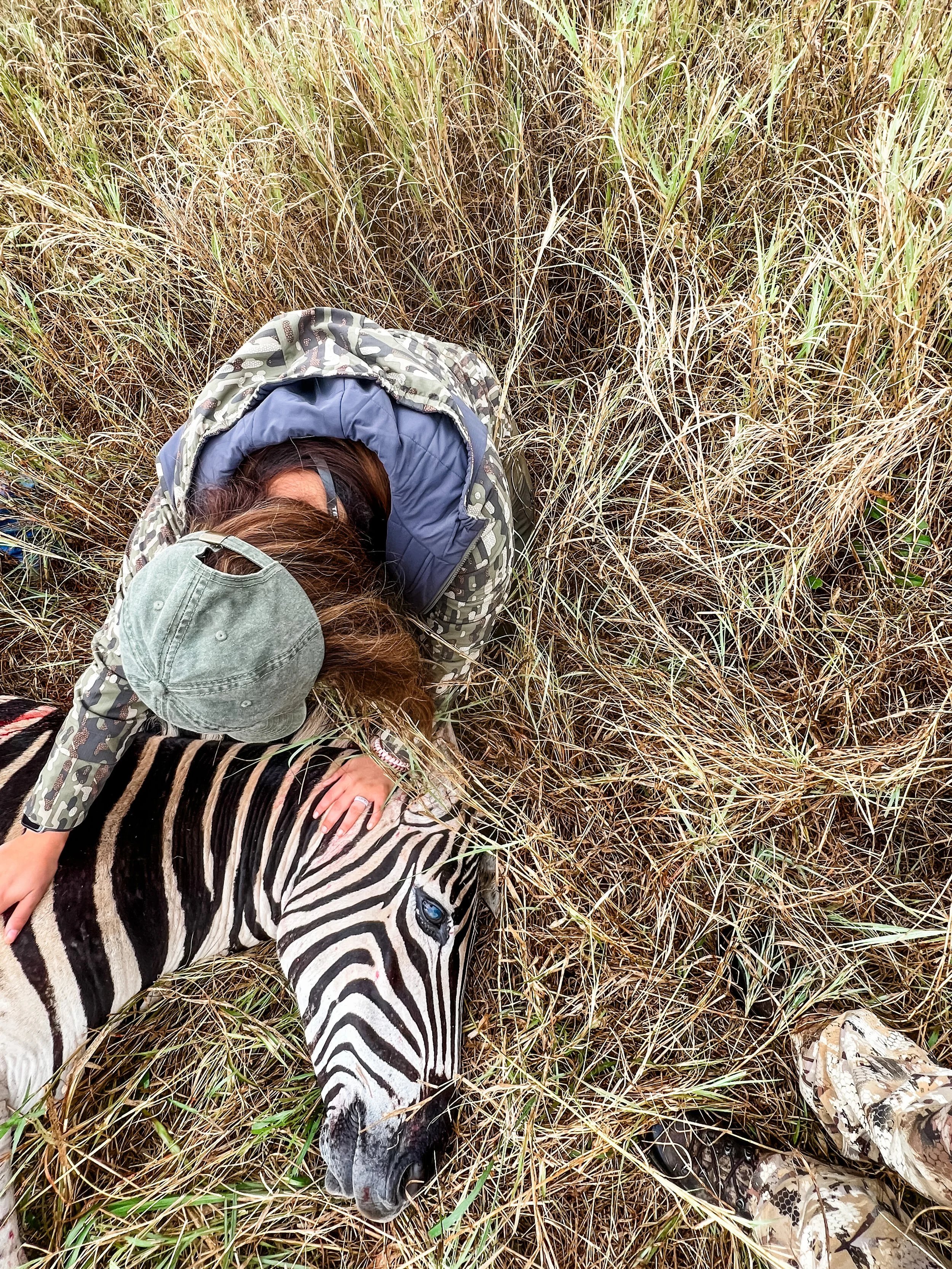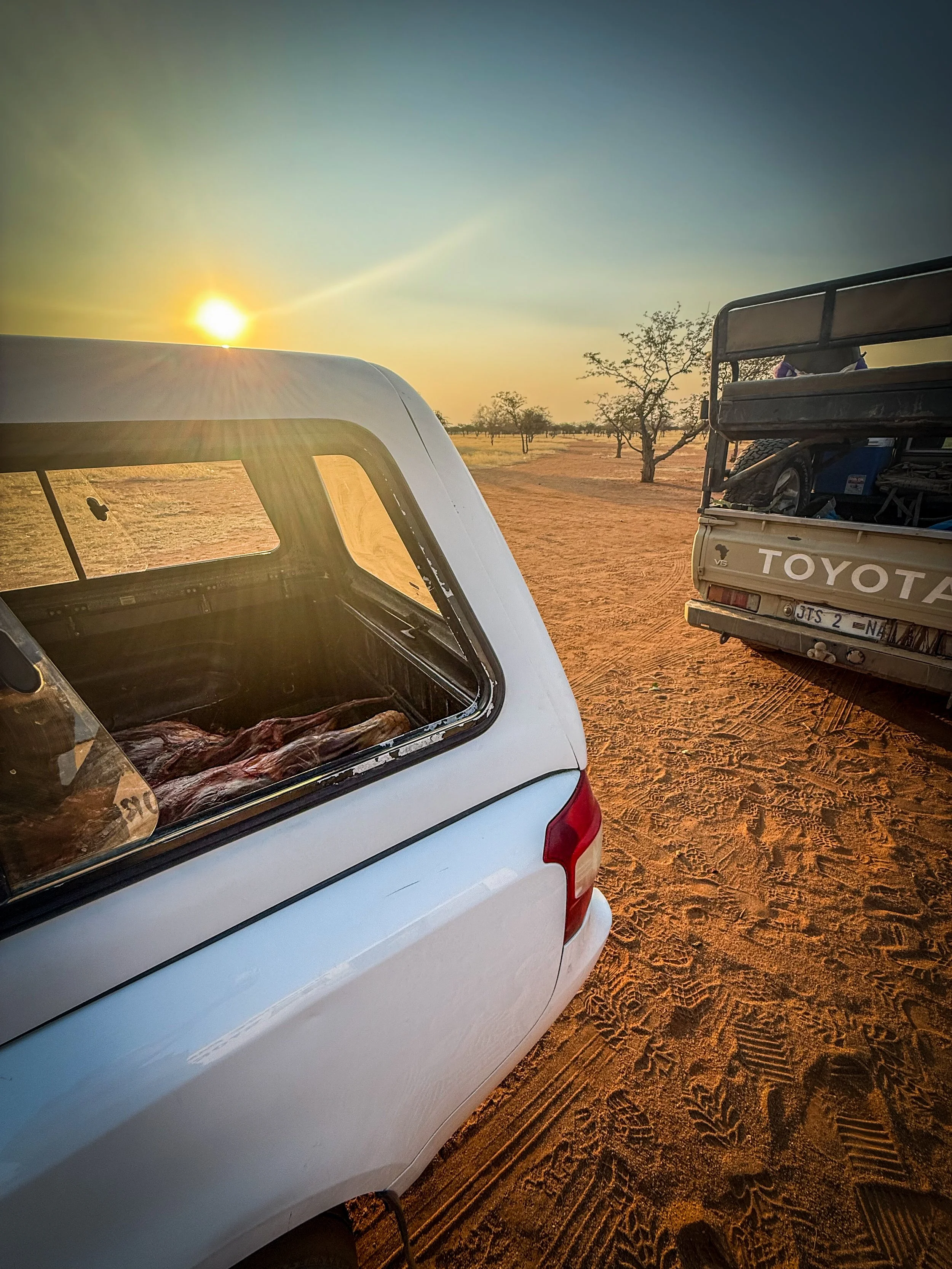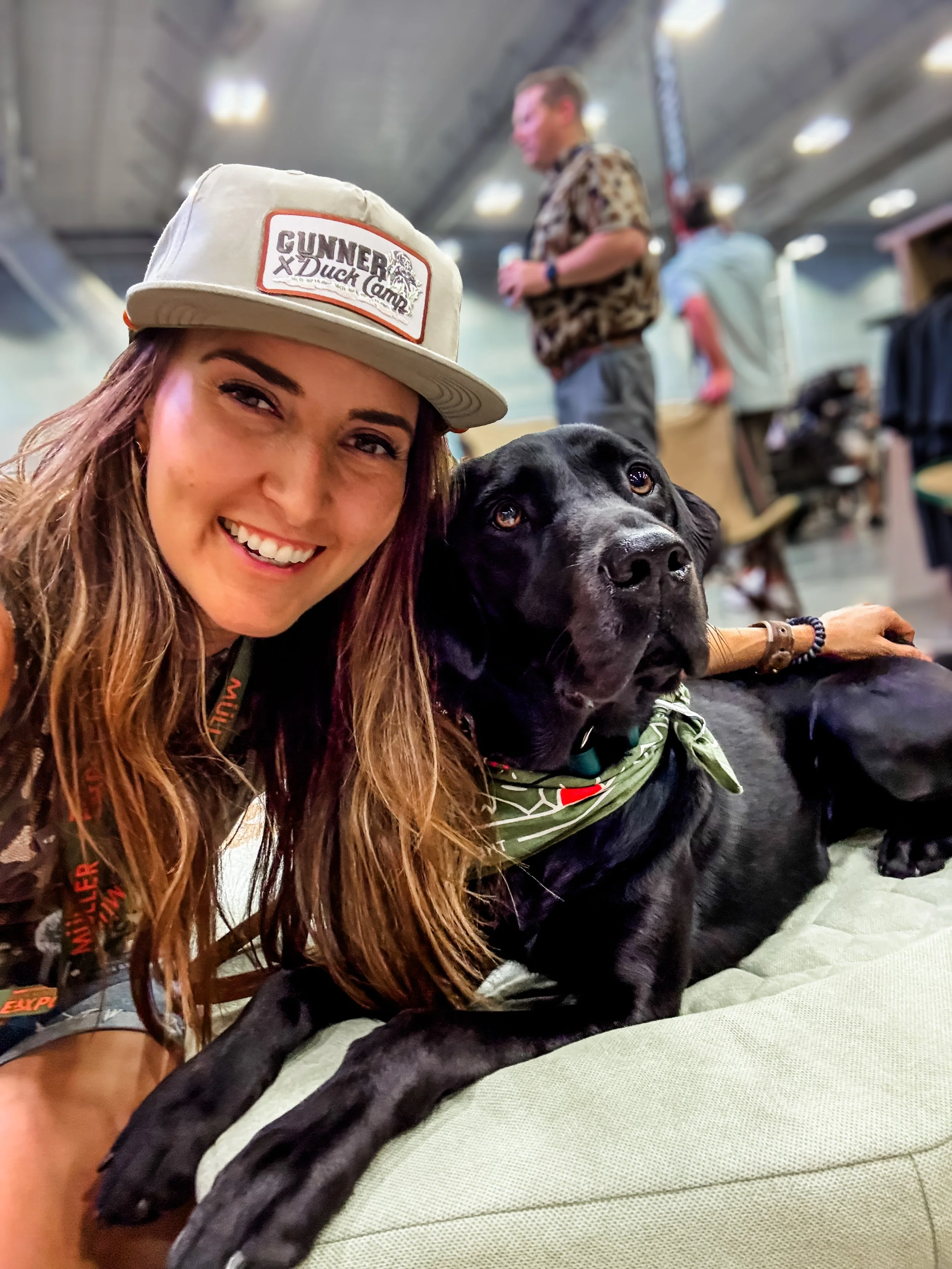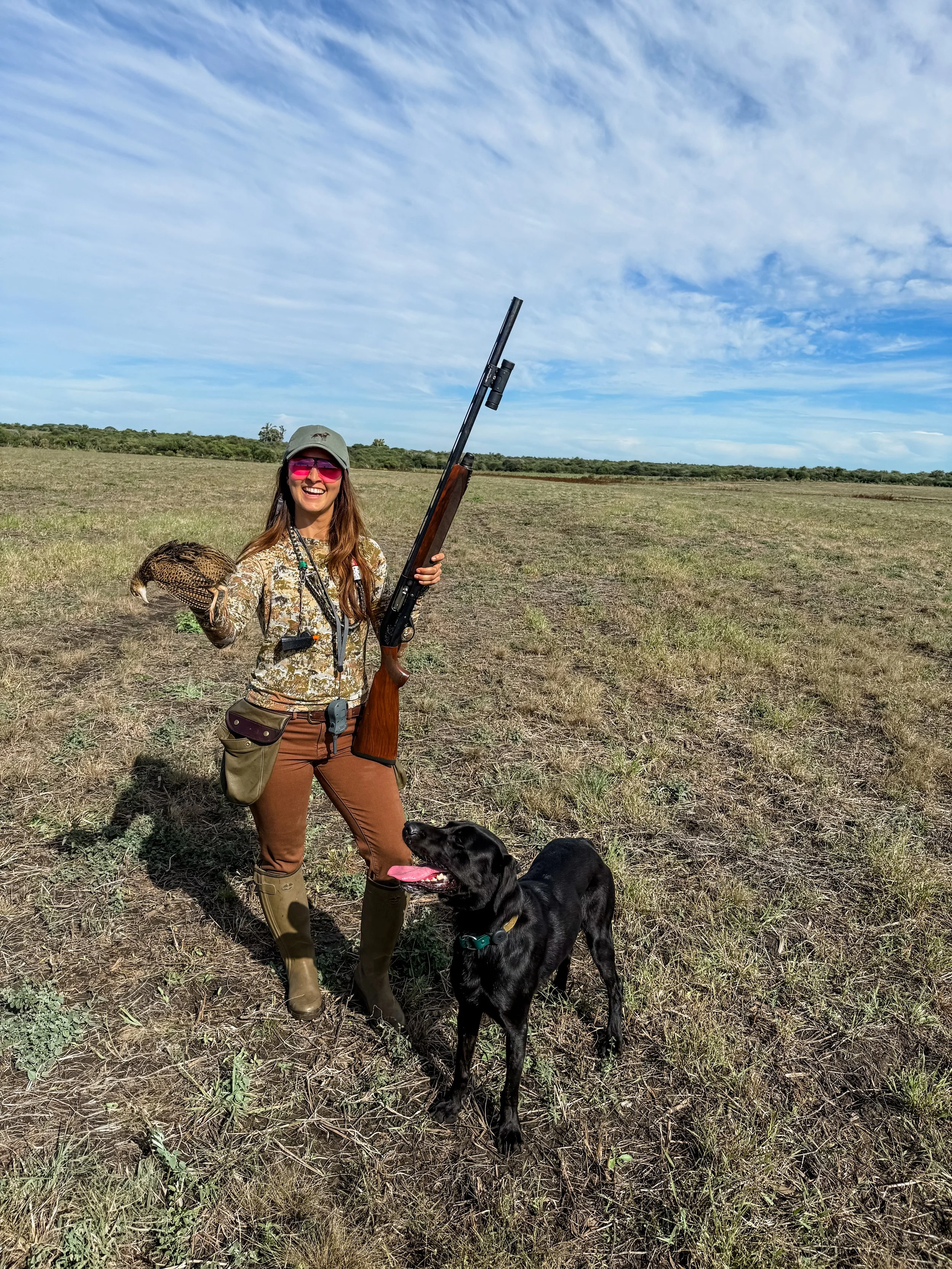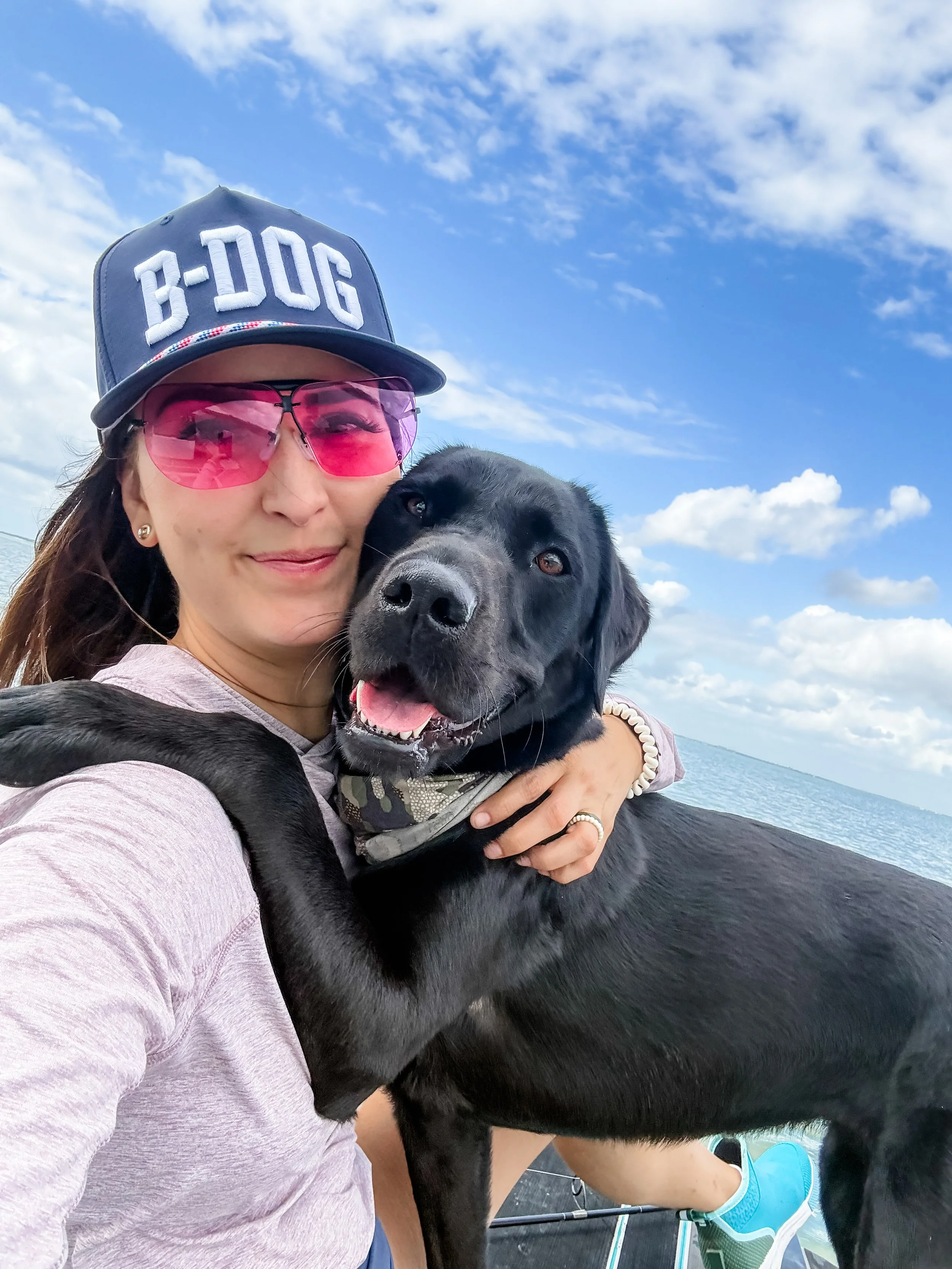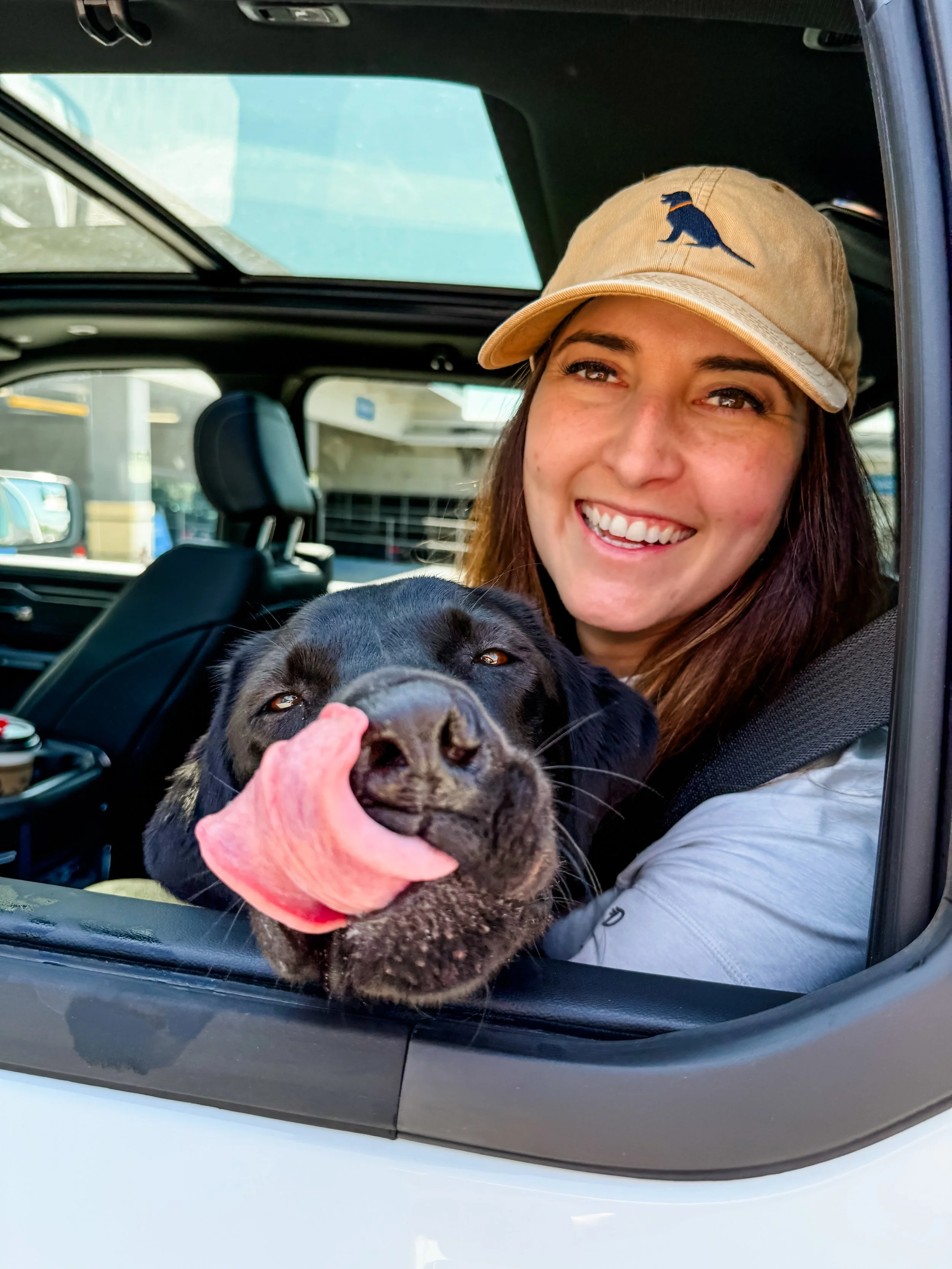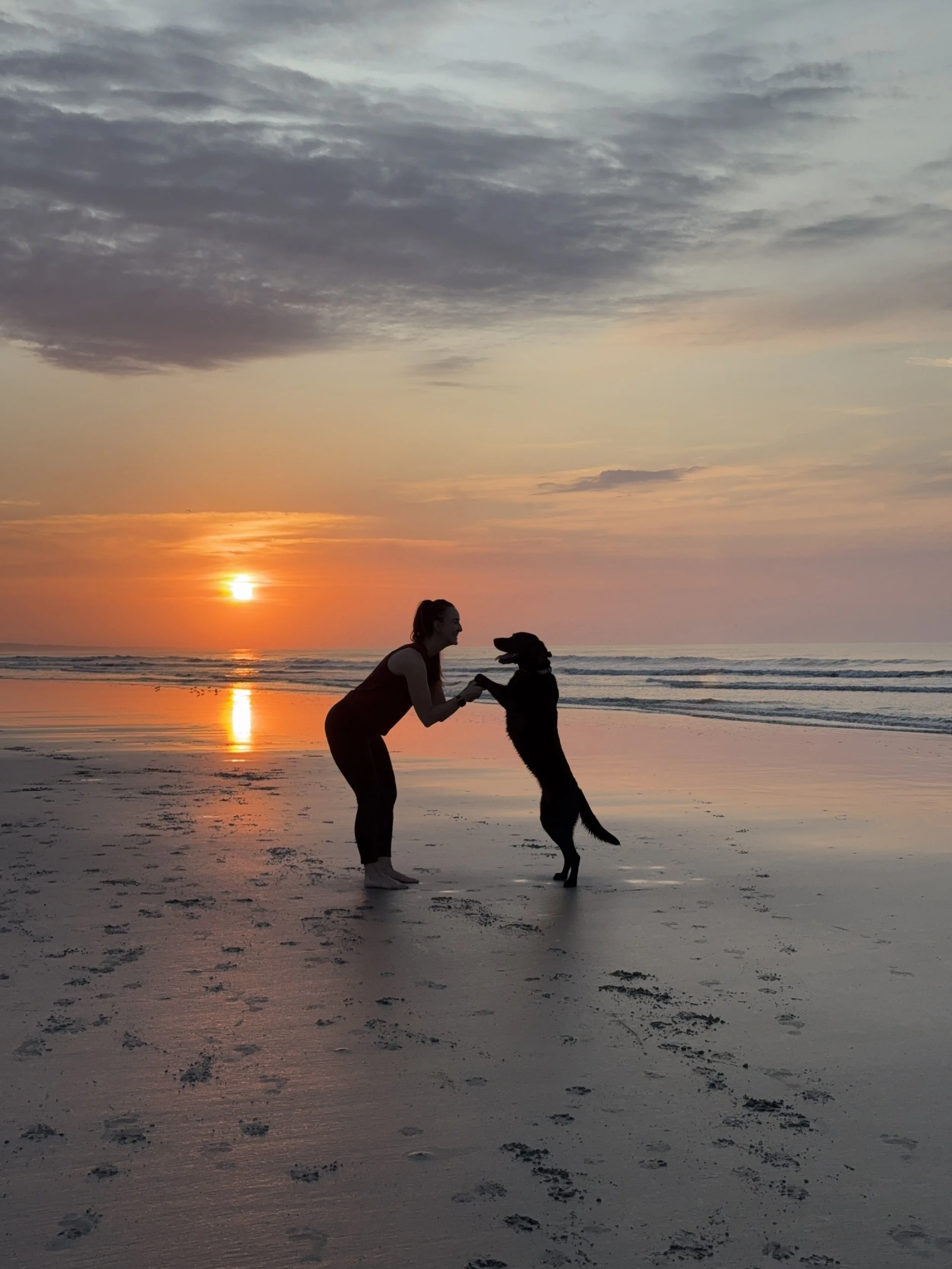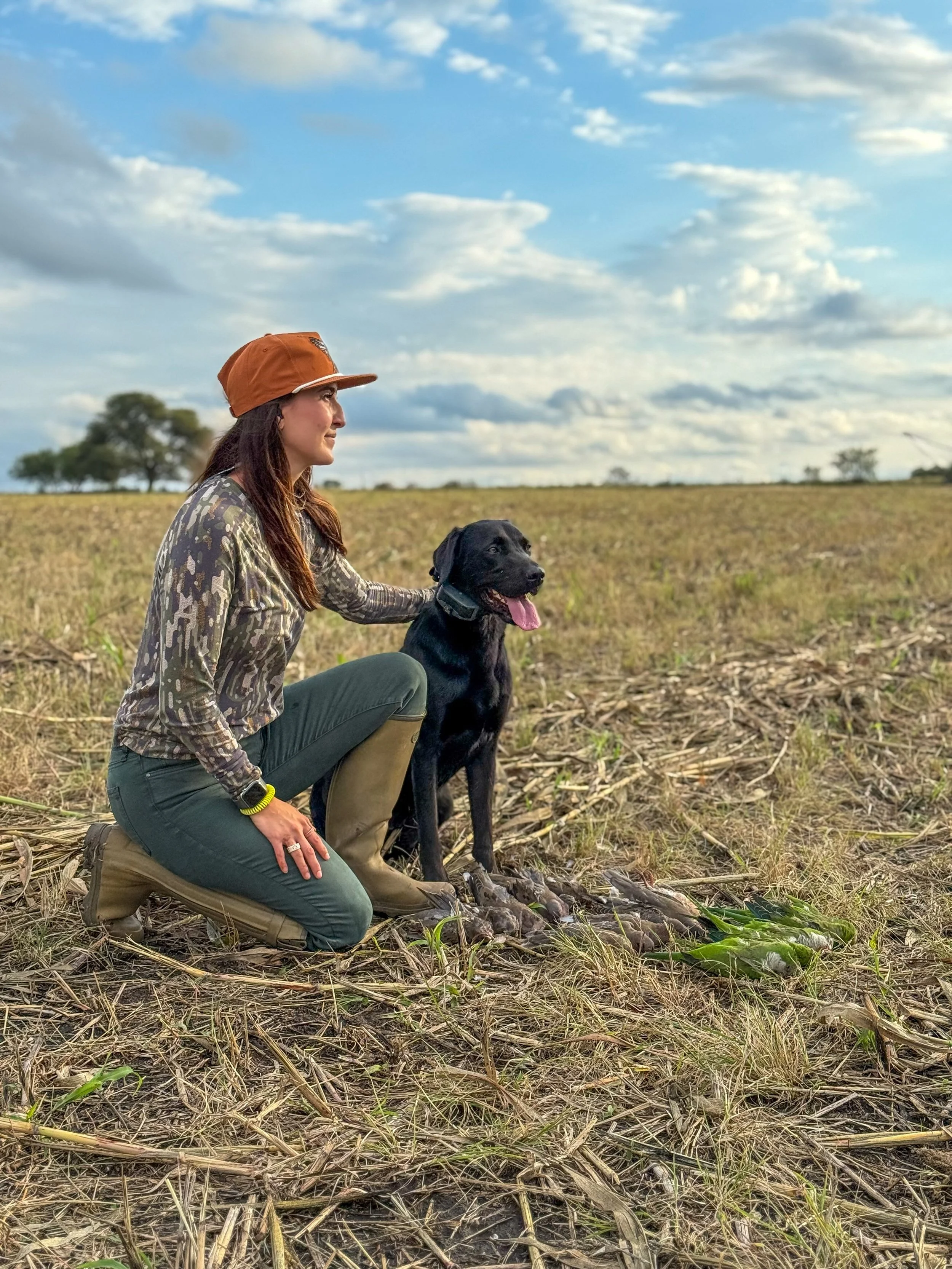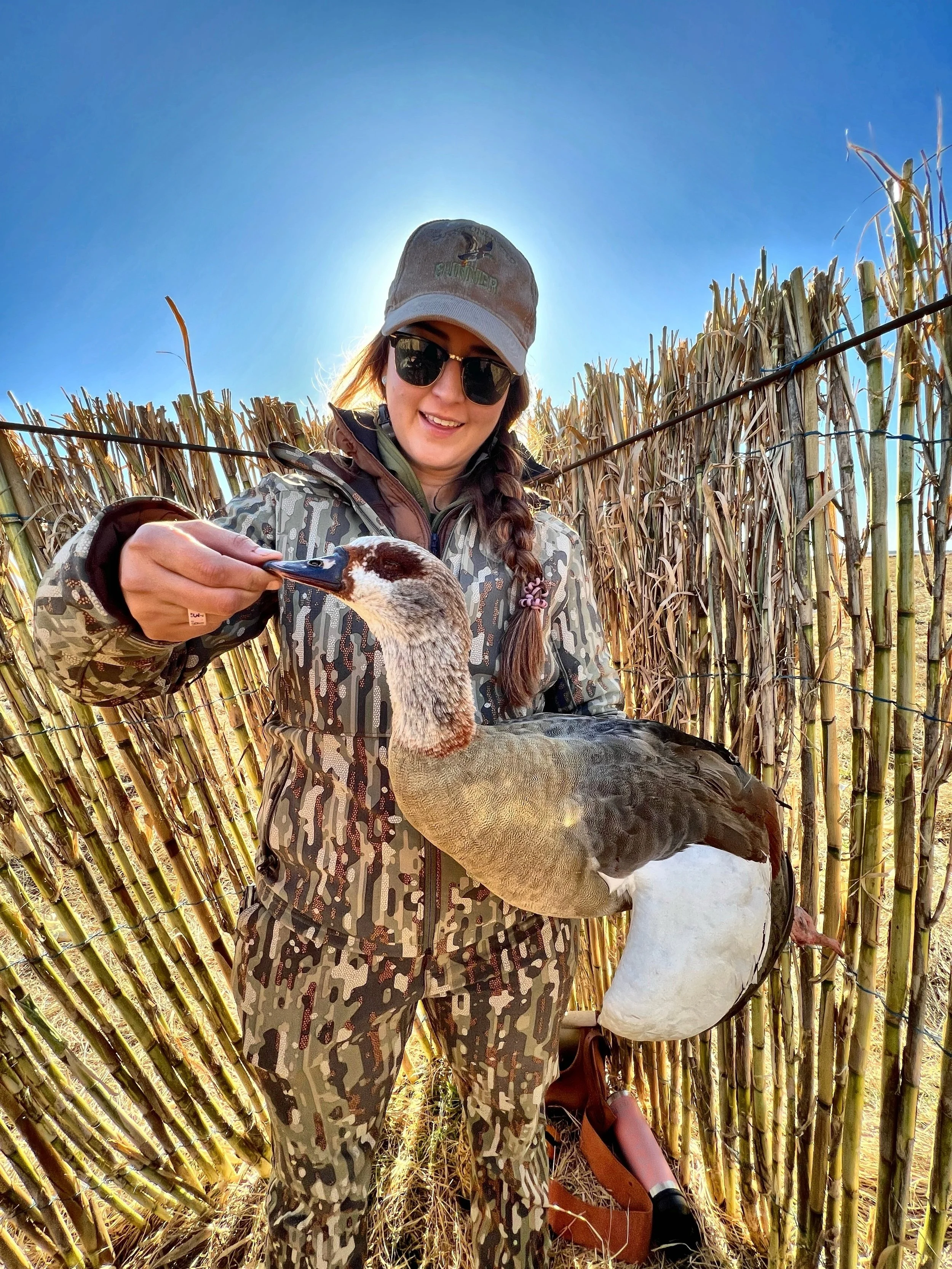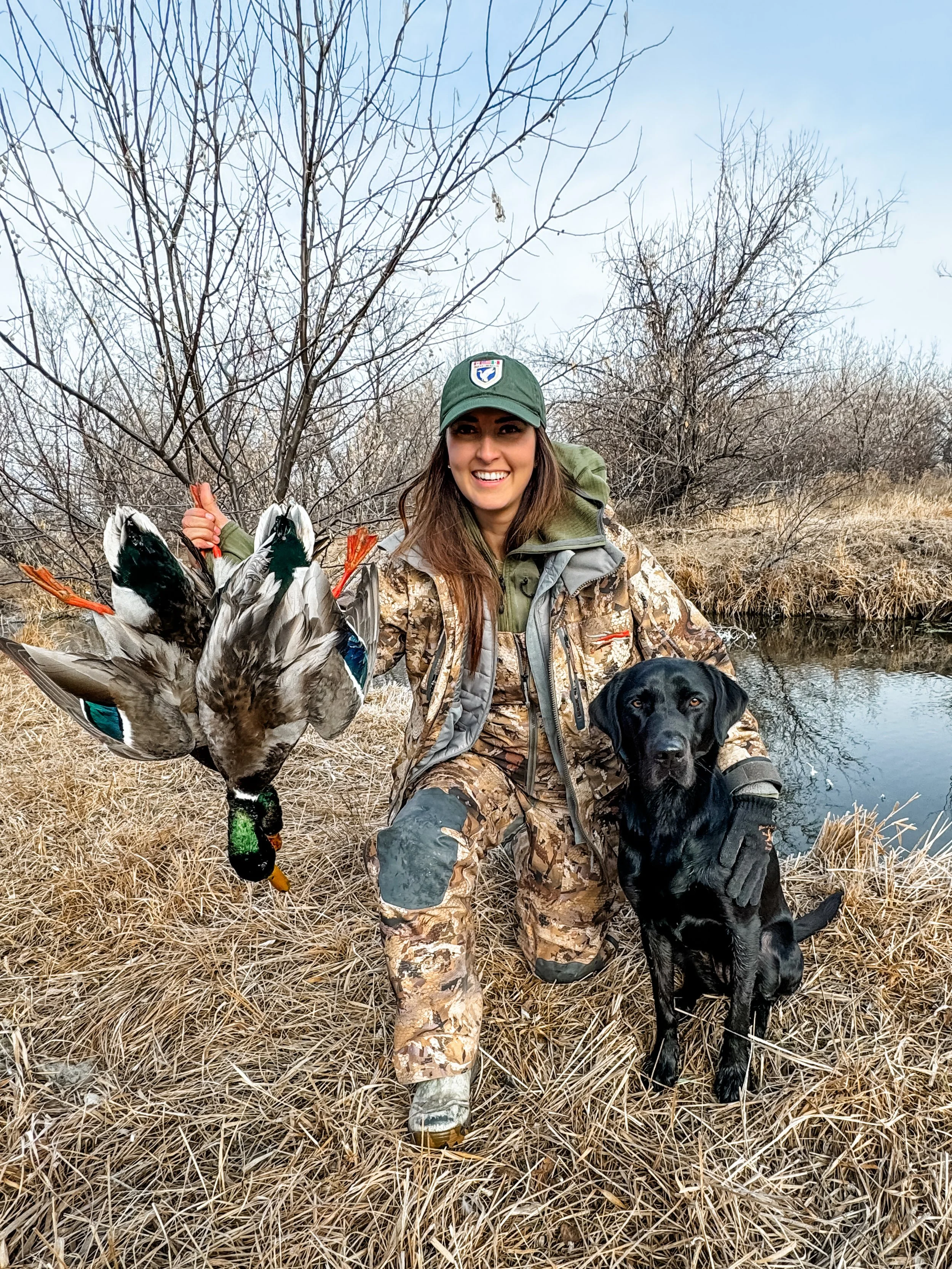Hunting a Giraffe in Namibia: From Doubt to Respect
Five giraffes. One rifle. A year and a half of hesitation. This is the story of how I faced one of the hardest hunts of my life in Namibia’s Kaokoland.
Auction Day at SCI
I looked wide-eyed at the ringman and asked, “Did we win?!” We were at the Ladies Sables Luncheon at Safari Club International’s convention in Nashville, and I somehow found myself bidding on a live auction hunt. Still riding a South Africa high from my first safari just a few months earlier, and maybe a few champagne glasses in, I raised my hand. A hunt package for three game animals in Namibia, and at such a great price if I won it.
I “won.” Or, as my husband would say, I bought it, but at a great deal. My payment, a donation, went toward the SCI Foundation’s education programs. The whole table of women clapped for me as I sat there wide-eyed, half laughing, half in disbelief. This was not planned. Not in the least. But now it was mine.
Then the reality set in.
A giraffe.
Could I actually hunt a giraffe?
Could I Really Hunt a Giraffe?
At first, I thought no. Not because I was against hunting. I was there at SCI after all, but because giraffes, like zebras, had been in a separate category for me. They were zoo animals, childhood book animals, the animals you loved simply for their beauty. Just months earlier in South Africa, I had watched giraffes float across the horizon with a grace that felt impossible for their size. They became one of my favorite animals to watch. And now I was supposed to take one’s life.
My first instinct was to see if I could sub the giraffe out. When I approached the outfitter, they explained that in Kaokoland, where this hunt would take place, quotas dictated what could be hunted. While we discussed that a substitution could be possible, it was unlikely. Old bulls were on the list. The words that stuck with me most were simple: “They feed a lot of people.”
I tucked that away, still unsure what to make of it. I had just gone through an emotional hunt with my zebra a few months prior, one that honestly made me question, in the moment, why I even hunted. That experience had been so heavy that I wasn’t sure I wanted to open myself up to something even more emotional with a giraffe.
Preparing for the Possibility
As I shared my excitement about this Africa trip planned for the following year, the same hesitation circled in my head: could I really do it? At first, my heart hesitated. But if I was going to honor the hunt I had committed to, I needed to prepare for the possibility that I would take a giraffe. And that meant buying my first-ever hunting rifle. Not just any rifle, but one capable of ethically taking down an animal of that size.
Fate works in strange ways. About a month later, I found myself at a suppressor event where Q LLC, the maker of the bolt-action rifle, The Fix, was in attendance. I had already fallen for Q after binging their podcast on my flight home from South Africa, and now here they were in front of me. Q was changing the game, building non-traditional hunting rifles and pioneering a new caliber: 8.6 Blackout.
Most hunters reach for the classic .375 H&H, but I wanted something I could use beyond one hunt. The Fix gave me that. With a barrel swap, I could switch between three different calibers depending on the hunt. Some traditional hunters on forums laughed when I mentioned the 8.6 Blackout, saying it wasn’t enough gun for something as big as a giraffe. But talking to the Q team at the event, they assured me this new caliber had the power, performance, and penetration needed.
Every piece of preparation, from the rifle I chose to the shot placements I studied, pushed me to stop thinking of giraffes as untouchable “zoo animals” and start seeing them for what they are in Namibia: game animals, part of a managed population, and ultimately, providers.
A month later, I had a Q Fix in my hands and made the commitment to myself that I was going to learn how to shoot rifles. This was a big deal. I had never been on a big game–only hunt before, always wingshooting. If I was going to hunt a giraffe, I wanted to do it right. I wanted to ensure I was capable of the most ethical, clean shot — one that would mean minimal pain and a quick death for any animal.
Kaokoland, Namibia: A Year and a Half Later
Fast forward nearly a year and a half, and there I was standing in the sands of Kaokoland, sweat dripping, heart pounding, my 8.6 Blackout Q Fix rifle in my hands. In that time, I had carried the thought of the giraffe with me: the hesitation, the questions, the quiet commitment I had made to be ready.
By day four of my Namibia safari, the zebra and springbok were already behind me. That left only the giraffe. The one animal I had been circling in my head since Nashville. What I didn’t expect was that it would take five different bulls before I finally found myself behind the sticks, staring through my scope at the animal I had once sworn I couldn’t hunt.
1. Nerves + Reality Check
The very first animal we tracked in Kaokoland was a bull giraffe, exactly what I had dreaded and hoped for. Dreaded because it was the first animal of the safari and I still felt uneasy. Hoped for because he was an old, dark giant, and my PH whispered, “This would be an epic bull.”
My heart pounded as we slipped off the truck and began our stalk, but he caught our wind, and he took off. Even if we pushed on, the rocky ground made recovery impossible. My PH shook his head. A giraffe that size, in terrain like that, could leave us stranded with thousands of pounds of meat we couldn’t get out. I felt both relief and frustration as we turned back.
2. Frustration
The second was another old bull, smaller in body but aged in the face, with one horn rubbed bald. We gave him a short stalk, but again the ground betrayed us. No truck could ever reach him. Twice now, it wasn’t my trigger finger that ended the hunt, but the land itself.
3. Anxiety + Patience
We glassed from the top of a mountain. I saw nothing, but my PH, with his trained eye, spotted a dark bull across the riverbed. We tried him twice, following tracks, catching his scent, swatting at mopane “flies” that are more like bees. Each time he slipped away. The trackers pointed us onward, reminding me to be patient. Bush will provide. Still, the nerves churned. This was the animal I had been most anxious about, and he had given us the slip twice.
4. Exhaustion + Respect
The fourth was all grit. We bumped an old bull in the riverbed, and he bolted. The trackers picked up his prints and we followed. Rifle slung, sweat pouring, I peeled layers while trying to keep pace. We pushed nearly two miles through heat and sand before my PH called it off. My body ached, but I also felt something else: respect. To cover that kind of ground, while I carried the weight of my rifle, was a reminder of just how powerful and resilient these animals are.
5. The Shot + Resolution
By the time the fifth bull appeared, I wasn’t thinking about giraffes anymore. We were headed back to camp for lunch, music on in the truck, when the brakes jolted us to a stop. My PH lifted his binos. Within seconds I was out of the truck, rifle in hand, scrambling to the sticks.
This was it.
The Shot
I followed my PH off the truck and we stopped at the edge of the riverbed. The bull was about a hundred yards in. The riverbed sat lower than the ground where the giraffe stood, creating a natural shelf with tall grass for cover. It gave us the perfect setup.
I got on the sticks and found him through my scope. My PH called out the placement: between the eye and the ear. I steadied myself, breath slow, finger on the trigger. And then he turned.
“Now behind the ear,” my PH whispered.
But I froze. Something in me said no. I needed to be certain. We hadn’t talked through that exact shot, and I didn’t want to risk wounding him.
“No. Get him to turn his head again,” I said.
My PH whistled, and the bull shifted just enough.
Now it was a frontal shot. A clean line.
I could feel the mopane flies crawling, landing, swarming around my face, but I locked in. The weight of a year and a half, all the hesitation and preparation, came down to this. I steadied my breathing, pressed the trigger, and the rifle cracked.
Watching Him Fall
The crack echoed through the riverbed, and I saw my giraffe drop. A massive body collapsing into the sand with a force I could feel in my chest. I racked another. But he didn’t take a step.
Relief hit me like a wave. All my nerves about the caliber, the rifle, my own steadiness, gone in that instant. The shot was clean. But then came the harder part.
We rushed forward to where he had fallen, and as we walked up, I was overcome with his presence. A true giant. His chest still lifted, faint and heavy, the final breaths of an animal that had lived nearly two decades in the bush. Tears welled, impossible to hold back.
At my PH’s instruction, I put two more rounds into his chest to help him pass quickly. The first shot had dropped him clean, but with an animal that massive, I didn’t want there to be any lingering suffering. It was the right thing to do.
While he took his final breaths, I whispered, “I’m sorry.” Not for hunting him, but because watching something so immense die is never easy. My PH told me this was normal for an animal his size, that it takes time for life to leave a body like that. But I stayed and watched, because I believe if you take a life, you should witness it fully.
I stood there, tears cutting through the sweat on my face, until his breathing slowed, then stopped.
Scars of a Warrior
After he passed, I stepped closer, reaching out to touch him, to feel his beauty. Standing beside him, I felt small. He was truly a massive creation of God, the most beautiful creature I had ever seen up close. His hooves were smooth on top and rough, like sandpaper, underneath. His hide was thick, his neck solid, his legs made of pure bone wrapped in an inch thick of skin.
Up close, his hide was that dark, chocolatey-brown, the kind of deep coloration that only comes with age. In giraffes, dark hides are the sign of an old bull, one that has lived his years, passed on his genes, and aged out of his role in the herd.
And then we noticed something so unique. Scars. Long claw marks raked across his hindquarters, his back legs, even deep gashes along his back. They had filled with thick old scabs, signs of a lion attack he had survived. This bull wasn’t just old, he was a warrior that had lived nearly two decades in the bush.
And one might think, “And then you took his life.” True, I did. But nature is brutal. Just the day before we came across a fresh giraffe carcass, a bull that had broken its leg and bled to death in the sand.
Many look at giraffes as gentle giants. That couldn’t be further from the truth. They are mean, and they fight. Bulls battle over dominance and breeding rights, especially the older ones, who try to hold off the younger bulls coming up in the ranks. In what’s called necking, they swing their long necks like sledgehammers, whipping their heavy heads with bony ossicones. The blows are violent, sometimes enough to knock another bull off his feet, even kill him. The carcass we saw the day before was from such a fight.
My bull, estimated at 17 or 18 years old, bore the marks of that life. Scars from lions. Ossicones rubbed raw. His head thick with calluses where he had taken hit after hit. He was proof of what it means to grow old in the wild.
And that’s the point of hunting in Africa. Old bulls like him are intentionally targeted. They’ve lived their years, passed on their genes, and often become too aggressive in the herds. By taking an old bull, you’re not removing an animal in its prime. You’re respecting the natural cycle, making room for younger bulls to come up, and providing food for the community in the process.
The Weight of the Work
After returning to camp briefly to pick up more men, it was time to go to work. The team put their skinning and carving skills on display as I set up a time-lapse. For nearly three hours I watched his body transform piece by piece: hide, skull, bones, quarters of meat stacked high.
I’ll eventually bring home the skull for a Euro mount, the full hide for furniture, and the leg bones with hooves intact. The rest, thousands of pounds of meat, went to the conservancy to be divided among the villages tied to this concession. Nothing was wasted. Families would eat because of this bull.
The truck groaned under the weight, tires sagging into the sand. I sat nearby, still staring at the empty space where he had fallen. The mopane flies lingered, the sweat still stung my eyes, but the noise inside me had gone quiet. For the first time since Nashville almost two years ago, I felt a shift. From dread, to responsibility, to something closer to peace.
Reflection
Looking back, this hunt taught me more than I expected. It taught me a new element of hunting: rifle hunting. It taught me to be patient, to wait for the right shot, and to trust that the bush would provide. After five bulls, it did. And not just any bull, but a warrior who had lived nearly two decades, survived lions, fought off rivals, and carried the scars to prove it.
And here’s one thing many people get wrong: this kind of hunting isn’t about taking away. It’s about making sure wildlife thrives. In Namibia, giraffe numbers have steadily increased in places where conservation programs, community conservancies, and regulated hunts are part of the landscape. Hunting fees pay for anti-poaching, habitat upkeep, and provide direct incentives for communities to protect the land. Without those incentives, habitat gets lost, animals decline, and wildlife areas shrink. We have seen this in Kenya after decades of bans on hunting, while countries like Namibia and South Africa have watched populations grow under regulated use.
Organizations like The Origins Foundation tell stories exactly like this one. They emphasize that when wildlife has economic value through legal and ethical hunting, land remains wild, local communities benefit, and species like giraffes thrive.
So when people ask me, “Why would anyone hunt a giraffe?” my answer is simple. Because hunts like this provide. They provide for conservation, for communities, and for the future of these wild animals. And this hunt gave me something too: a deeper respect for the animals, for the land, and for the responsibility we carry when we choose to hunt.
Want to know when I share my next story?
Sign up through the link below to get updates straight to your inbox.
Patience, Springboks, and Cotton Candy
A lesson in patience during my Namibian safari: two days of stalks, missed chances, and finally a clean shot on an old springbok - complete with a cotton candy surprise.
My grandmother always told me, patience is a virtue. I didn’t realize how true that would become until I found myself crawling through the African bush, heart racing, waiting for the right springbok ram. Out there, patience isn’t just a saying — it’s the line between an ethical shot and a missed opportunity. And strangely enough, sometimes the payoff smells like cotton candy.
Day Two: First Lessons in Patience
Our second day of safari had already been successful, earlier in the afternoon I had taken a beautiful Hartmann’s zebra. With daylight left, we set out looking for Springbok.
We spotted a herd and planned a stalk up the riverbank to avoid being winded. I had never stalked game before this trip and the rush was unforgettable. My PH led the line, then me, and behind us our two trackers, Tjevia and Tani. When we paused, the trackers glassed the herd while I tried to steady my breathing, heart pounding with adrenaline. Each step I searched for bare sand, reminding myself, quiet steps, stay calm.
From behind a tree, about 300 yards out, we watched the herd. But there were too many eyes - forty springbok in the open with nowhere to hide. My PH called it, and we retreated.
Driving back, we spotted two solid rams that had split from the group. This time it was just me and my PH off the truck. As I got into position, I was grateful for my illuminated reticle, perfect for low light. But I couldn’t line up quickly enough before the ram walked on. With dusk falling, I let the moment pass. It was more important to me that every shot on this trip was a clean, ethical one.
That evening, I carried no disappointment. I already had the zebra, and patience was teaching me that passing was sometimes the better choice.
Day Three: A Long Crawl in the Grass
The next morning we set out again for springbok. Along the way we bumped four Dik Diks - rare to see - and I wondered if it was a sign of good luck.
Sure enough, we soon spotted a herd standing in the open bushman grass. My PH explained that after years of drought, Namibia finally had rain, and where bare sand had been last season now stood tall grasses, some nearly three feet high.
Through his binoculars, my PH picked out a large ram bedded under a tree. He told the trackers to wait with the truck, and the two of us began our stalk.
At first we crouched, using distance as cover. My PH plucked handfuls of grass, holding them in front like a fan to break up our shape. Soon the stalk turned to crawling, sometimes on all fours, sometimes crab-walking, my Q Fix rifle with folded stock slung across my back. At each pause, he glassed while I focused on deep breaths in, deep breaths out, calming the adrenaline and saving steady aim for when the time came.
Finally, he motioned for me to dial to 150 yards and get ready. On the sticks, I found the ram in my scope but the tall grass swallowed his body, leaving only head and horns. I felt uneasy. It wasn’t enough for me to identify my target. I whispered to my PH that I couldn’t take the shot.
We crawled further, but after nearly an hour, the tall grass still blocked a clear view. Reluctantly, we backed out. It was the right call, even if it stung.
The Shot That Counted
Back at the truck, we drove closer. To our surprise, the herd didn’t spook. We seized the moment.
I jumped off, set on the sticks, and dialed for 170 yards. The ram we had been after trailed at the back of the herd. Through my scope I found the dark horizontal line along his body, followed it forward, and settled just above the leg. Squeeze. Shot.
The ram jolted, ran a short distance, and went down. The adrenaline crashed over me. After the long stalks and the waiting, it was done.
My PH and I exchanged fist bumps, both of us knowing how much work and patience had gone into that moment.
Cotton Candy and Reflection
As we approached the ram, the dorsal crest of white hair on his back stood straight up. My PH explained that springbok release a sweet scent when excited or stressed, like cotton candy. I leaned in, curious, and there it was, a strange, sweet smell rising from the gland sacs beneath the hair. Unique, unforgettable, and bittersweet.
He was an old ram, eight or nine years with secondary horn growth. Taking an aged animal, past its prime, felt right. Patience had delivered the opportunity for a clean, ethical shot, and the bush had provided.
Sharing the Meat
Back at camp, Alfons greeted me with his wide smile, just as he had after the zebra. He shook my hand firmly, his crooked eye glinting, only three fingers wrapping around mine. “Thank you for zebra,” he had said before. Now: “Thank you for springbok.” Knowing that much of our wild game meat would be shared through the conservancy, ensuring families in the community received food. Alfons’ gratitude reminded me again how nothing here goes to waste.
From the Field to the Table
The following evening, our camp chef Jackson prepared the springbok for dinner. He cooked it to perfection. Medium rare, tender, and rich with flavor. To my surprise, I loved it even more than zebra. It instantly became my new favorite wild game to eat, a fitting close to the patience and effort that went into the hunt.
Closing
As I replayed the stalk and shot in my mind, my grandmother’s words echoed again: patience is a virtue. In Africa, patience meant more than waiting for a shot; it meant discipline, restraint, and respect for the animal. The reward wasn’t only in the harvest, but in the hours of crawling through grass, the lessons learned about myself, the delicious springbok shared around our campfire, and the people I shared it with. From my PH crouched beside me in the bush to Alfons smiling with meat in his hands.
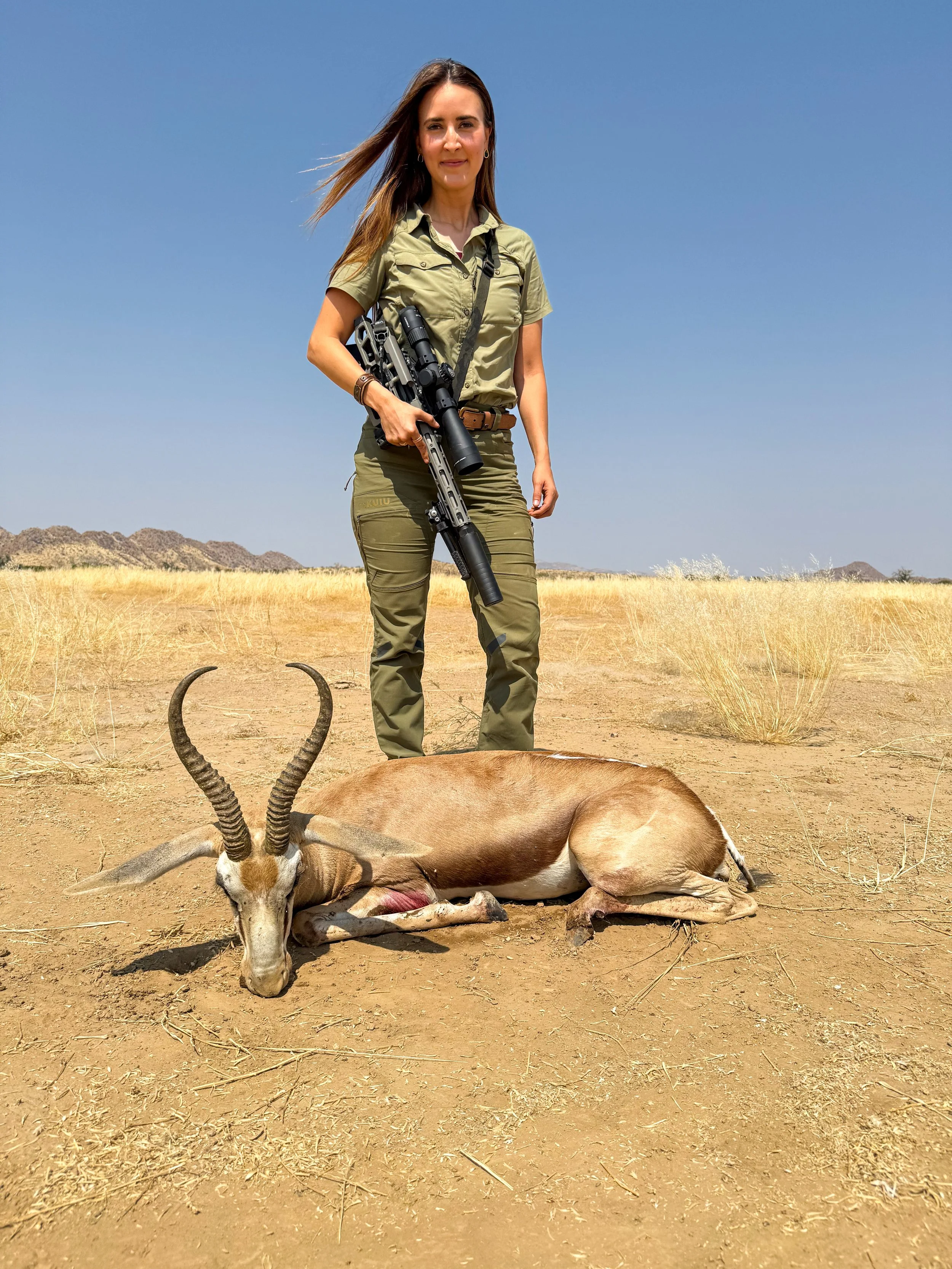
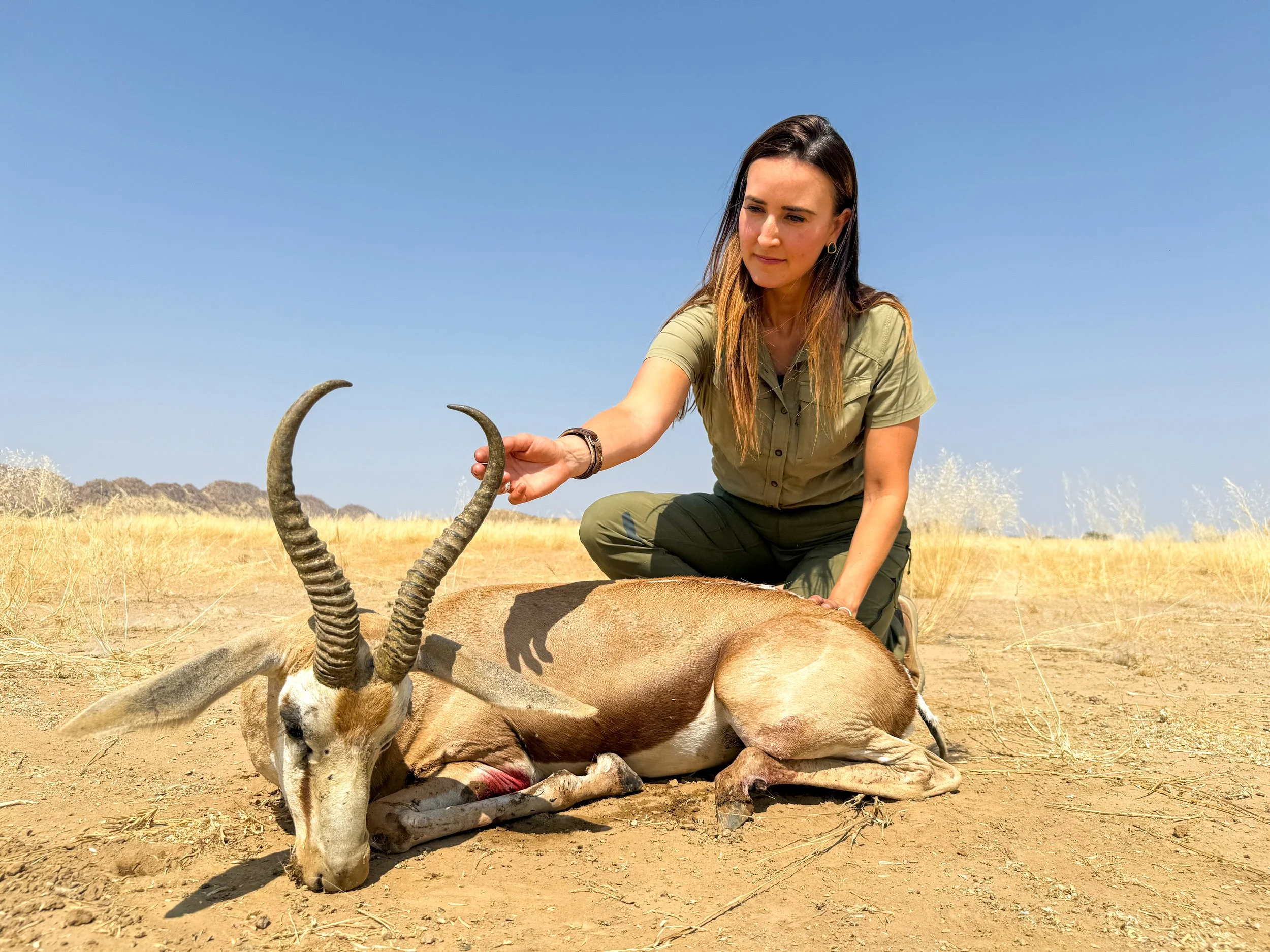

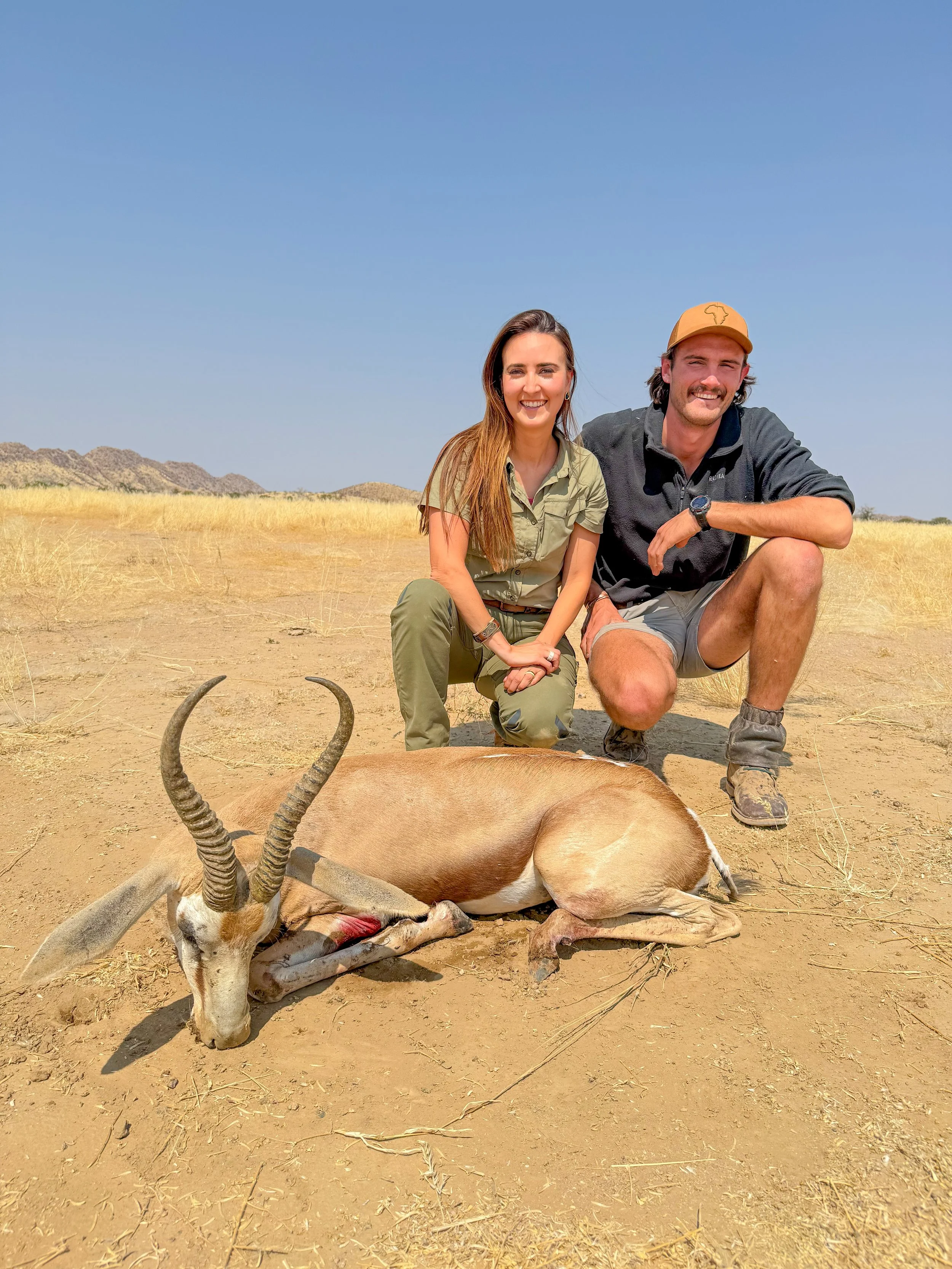
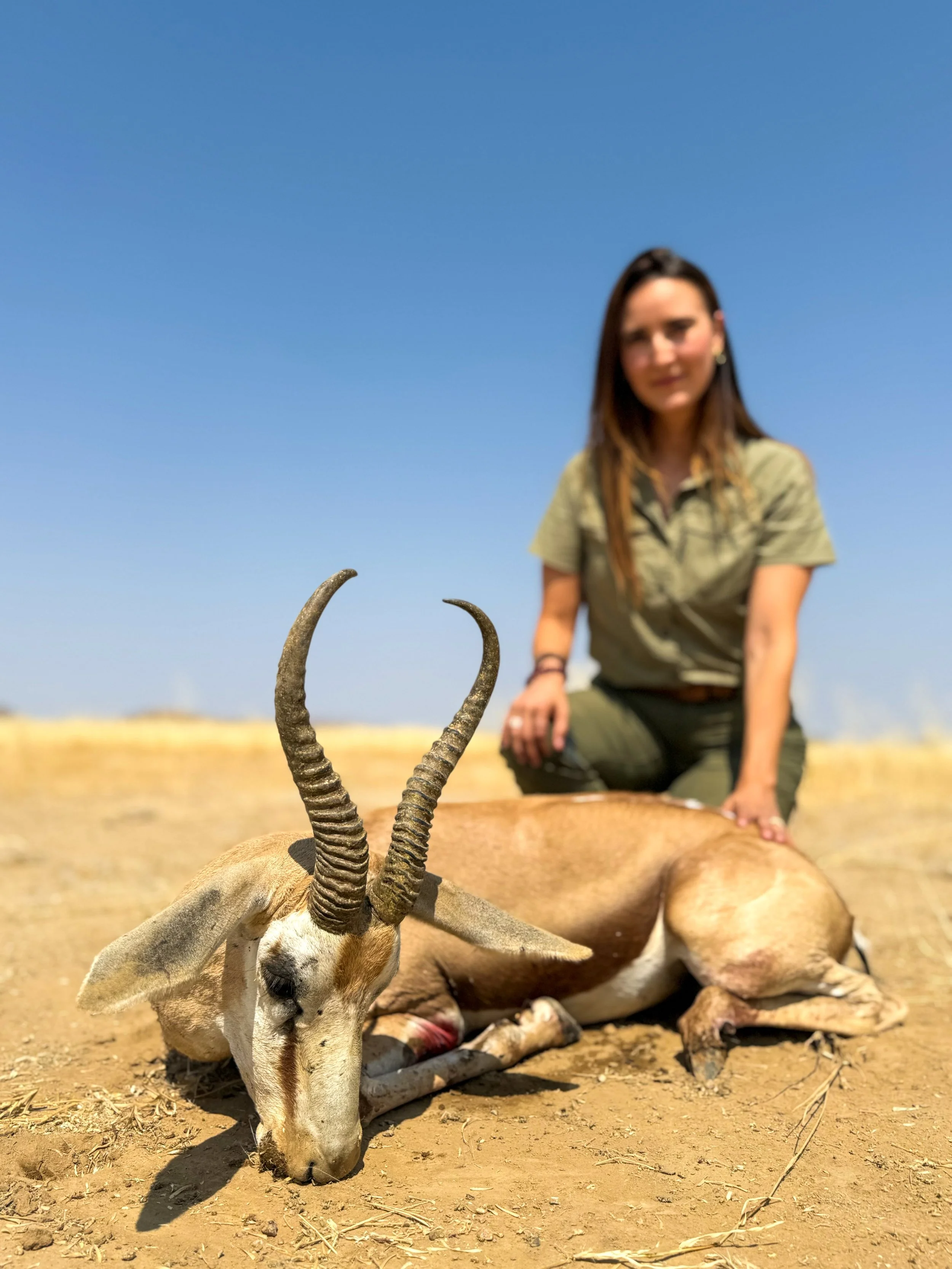
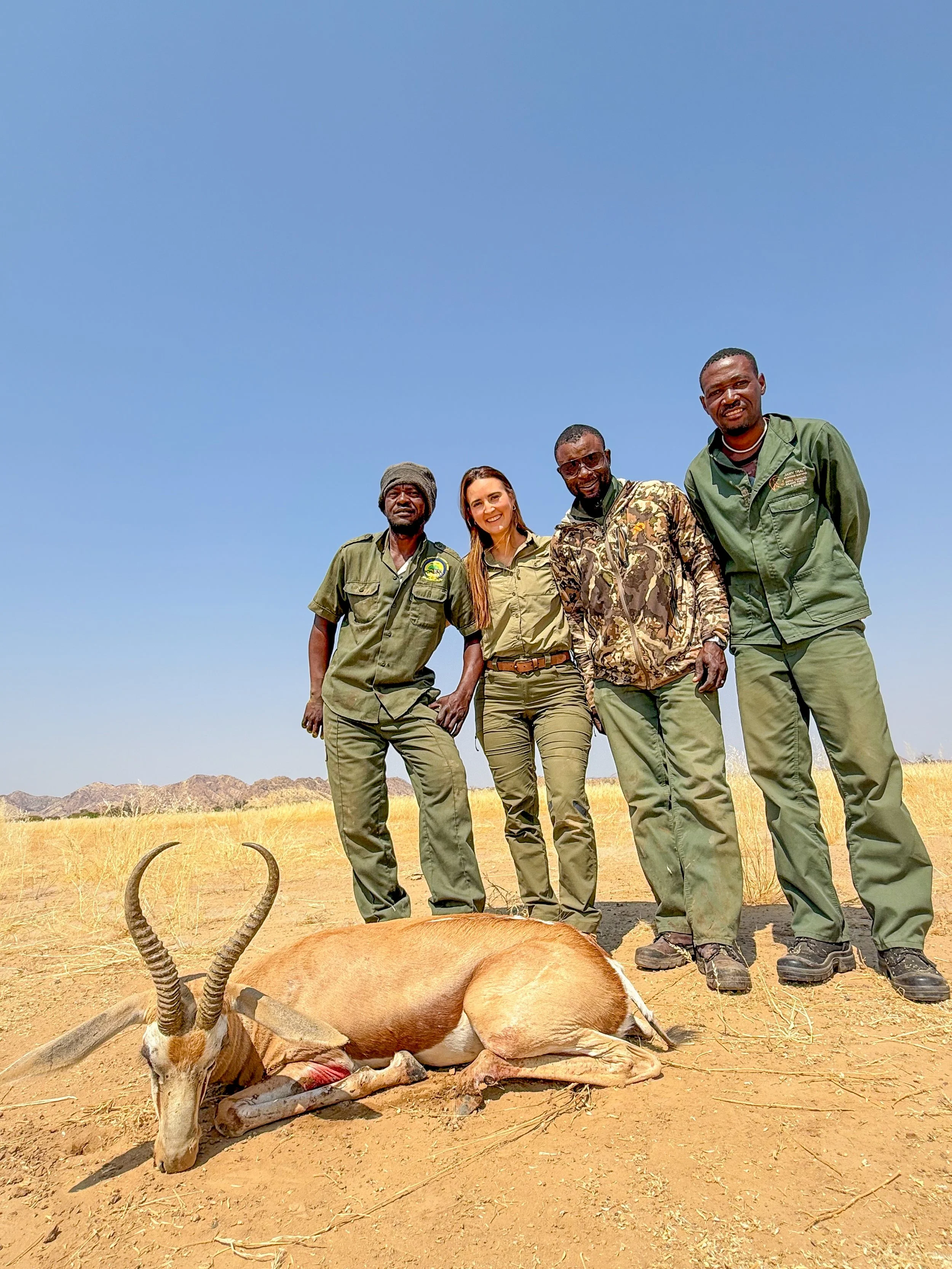
Thanks for following along on my springbok hunt. If you enjoyed this story, subscribe to the blog so you don’t miss the next adventure.
Hunting in Africa: Nothing Goes to Waste
What really happens to the meat after a hunt in Africa? In Namibia, nothing goes to waste — from the skinners in the field to conservancies and local villages.
Trophy Hunting Misunderstood
In my previous blog, I talk about how safari hunting is so much more than a “trophy hunt.” Many critics of African hunting have given this term a negative connotation, making it seem as though hunters are only there to mount the animal and take the head as a prized possession.
Merriam-Webster defines “trophy” as: something gained or given in victory or conquest especially when preserved or mounted as a memorial./trop
For many hunters, mounting the animal is about memory - a memento to remember the experience, the challenges, and the triumphs. It’s a way to respect that animal into the future.
Hunters are not stone-cold killers. They deeply respect the animal’s life, and there’s a bond between hunter and game that non-hunters may never understand. While this blog will focus on what happens to the rest of the animal, I’ll dig deeper in a future post into how hunting is conservation.
The First Steps After a Hunt
Once an animal is shot with a rifle or bow and killed, time is of the essence. Hunters quickly take photos, another way to memorialize the experience, before the animal is skinned and carved.
Whether this happens in the field or at a skinning shed depends on where you are hunting. In Kaokoland, Namibia the lands are vast, and we were often far from a shed, so trackers would begin their skinning right there in the field. For large game animals, additional skinners are often brought in to help.
Hunters also decide at this stage what type of mount or rug they’ll do. This determines how the skinners approach the animal, a detail I’ll get into in a future blog.
Nothing Goes to Waste
Once the skin is prepared, skinners move on to carving the rest of the animal. Unlike in the States, where I often see hunters only breast out birds and leave the rest, in Africa nothing goes to waste.
I remember two years ago in South Africa: my skinners were working on my nyala when a woman walked up out of nowhere. After speaking with the crew in Afrikaans, she began cleaning the intestines of the antelope. She wasn’t connected to our camp, just someone who heard we had a kill and came to ask for some. She would flush, clean and later eat or sell the intestines casing. My PH explained that 99% of the animals are used in Africa. Even our geese that we gave to a village; when asked how they cook them up, the matriarch of the village explained in Afrikaans to my PH that she boils them whole after plucking, every bit is used.
In Namibia, it was the same. Nothing wasted. I even filmed a short time-lapse of my zebra being processed in the field. After roughly 90 minutes, all that was left was the contents of the large intestine. NOTE below are a few photos from the carving process with images, if uncomfortable, just scroll past.
From Field to Village
In Kaokoland, we hunted on what’s called a concession. Each concession has a conservancy office and conservancies are made up of local people who live on the land. The conservancy manages the meat and divides it among families.
What many anti-hunters don’t realize is that rural African villagers often lack access to protein. Unlike you and I, who can pick from endless options at a grocery store, protein is a luxury. Many families live off corn or other carbs. Children in the Himba tribe, for example, showed signs of protein deficiency with bloated bellies.
After my zebra hunt, we drove more than an hour over rocky mountain roads to deliver the meat to the conservancy. There, the Game Officer from the Ehi-Rovipuka Conservancy accepted it, would lock it up, and eventually it would be divided amongst families.
We met with Herero villagers who would receive the meat. At the local store, we bought celebratory Black Label beers and shared them with the people. One woman, Maami, kindly took photos with me — though I wished I could understand their Herero language.
Better Than Beef
Not all the meat goes to villagers. In South Africa, part of my zebra went to feed our camp and staff. The rest, rich in yellow fat and not as edible, was delivered to a wildlife cat rehabilitation center, Emdoneni Cat Rehab Centre. There, injured cats are rehabilitated and released back into the wild.
This was rewarding to know that my zebra not only provided protein for people but also supported the conservation of other wild animals.
Many ask me what zebra tastes like. To Westerners, it feels foreign, even taboo, to think of eating something “like a horse.” But for me, eating the animal I’ve hunted is a sign of respect. Two years ago, when I tasted zebra for the first time, I was shocked at how much I loved it. After resting for 24 hours, the steaks were tender, rich, and flavorful. I remember describing it as better than beef.
-
Not all zebra are the same when it comes to meat. The zebra I hunted in South Africa two years ago was a Burchell’s zebra, and their fat is very different from the Hartmann’s mountain zebra I hunted in Namibia.
Burchell’s Zebra (plains zebra): Their fat is a deep yellow color due to the carotenoid-rich grasses they graze on. While it looks striking, the fat is waxy, strong-tasting, and doesn’t melt down well in cooking. Instead of adding flavor, it coats your mouth with a grassy, rancid taste. Because of this, skinners often trim most of it away. The lean meat is delicious, but the fat itself isn’t appetizing.
Hartmann’s Mountain Zebra: These zebras live in harsher, rockier environments with very different forage. As a result, their fat is much whiter and cleaner-tasting. Hunters and locals both consider Hartmann’s zebra to have superior eating quality.
This distinction is why, in South Africa, part of my Burchell’s zebra - especially the fatty hindquarters - went to the Emdoneni Cat Rehabilitation Centre. For the cats, that fat was actually an asset: a high-calorie food source that helps injured or orphaned predators recover. For people, trimming it off meant the lean zebra steaks we did keep were tender and flavorful.
Hunting Is Conservation
As you can see, nothing goes to waste with safari hunting. Minus the feces, every part of the animal is used. Families in rural villages receive protein they otherwise wouldn’t have. Wildlife rehabilitation centers benefit. Hunters themselves taste and respect the resource they’ve harvested.
I’ll share more in a future post about how hunting ties directly to conservation quotas, red-line regulations, and the sustainable use of wildlife. In the meantime, if this topic interests you, I encourage you to check out The Origins Foundation — one of my favorite resources for understanding the truth about hunting and conservation.
Until then, stay connected with me by signing up for my newsletter, you’ll be the first to know when my next blog goes live.
Full Circle — My First Zebra in Namibia
Two years ago, a missed zebra shot tested me in ways I wasn’t prepared for. In Namibia, with my own rifle in hand, I finally had the chance to make it right. This is the story of my first zebra — and the lessons that brought me full circle.
Looking Back: South Africa, Two Years Ago
Two years ago, I found myself behind a hunting rifle for the first time. I had traveled solo to South Africa for an international bird hunting trip: ducks, geese, and upland birds across three provinces. Picking up a rifle wasn’t part of the plan. After some shots at the range I felt confident enough to try for a Nyala, one of South Africa’s spiral-horned antelopes.
When the Nyala presented itself, I took a clean shot and it expired quickly. Relief and pride washed over me. For a first big game experience, it couldn’t have gone better.
The very next day, I decided to go after a zebra. That’s when things changed. On my first shot, I flinched at the trigger. The bullet sailed under her belly and struck her left front knee. My journal entry says it best: “She was hit but didn’t really run as I broke her leg. Some of the herd stayed close… surrounding her, so we got out of the truck to get closer for a follow-up shot.” My heart pounded as guilt sank in. Both my PH and Ramsey, who was with me, spoke at once, and I snapped that I couldn’t focus. On the second shot, she dropped, and it was over.
Relief and sadness collided. I thanked God for her, then stood for photos, trying to keep myself composed. But as the trackers loaded her into the truck, something strange happened. Three zebras came back — one about her size, maybe a little smaller, and two even younger.
It’s not common for a herd to return after a hunt. Most outfitters and PHs I’ve spoken to since have said they’d never seen anything like it. Yet there they were, no more than 15 yards away, watching. Tears ran down my face as they drew closer. I whispered, “I’m so sorry,” over and over, convinced I’d taken their mother away.
That abnormal return made the moment even heavier. It turned an already emotional experience into something I will never forget.
⸻
Namibia: My First Plains Game with My Rifle
Fast forward nearly two years. I was back in Africa, this time in Namibia, on a safari package I had won at Safari Club International. The target list had options, but on Day 2 of the hunt, fate presented me with zebra again.
It was past lunch and we were headed to camp when one of the trackers spotted three Hartmann’s zebras high on a rocky hill. My heart raced. Of course, the first animal in Namibia would be a zebra. Memories of South Africa flashed back, but so did the hours of practice I’d put in with my first rifle, the Q Fix in 8.6 Blackout. I knew this time I was ready.
My PH estimated the range at 120 yards. The rangefinder confirmed 115. I got on the sticks, picked out the zebra, and settled my reticle. Before nerves could creep in, I exhaled and squeezed. The shot was solid. She bolted 15–20 yards, then to everyone’s surprise, flipped forward off the rocks and came to rest. My PH had never seen a zebra do that before.
We climbed the hill, excitement replacing nerves. No tears this time — only gratitude. I prayed over her, thankful for the experience and the redemption of a clean, ethical shot. Roelof, my PH, grinned and said, “Bloody good job, madam. Perfect shot, eh. You put it exactly where we said.”
⸻
What This Hunt Means to Me
That moment meant everything.
Taking a zebra in Namibia wasn’t just another check mark on a list. It was redemption. It was growth. Proof that the hardest lessons shape us into better hunters.
Two years ago, I shot my first big game animal: a nyala.
The next day, August 9, 2023, I experienced one of the hardest hunts of my life with a zebra.
And two years later, almost to the date — August 10, 2025 — my first animal in Namibia, with my own rifle, was a zebra.
Full circle.
This hunt reminded me that the journey matters as much as the outcome. Hunting will always bring highs and lows, clean kills and hard lessons. It’s those moments together that make us who we are in the field.
Words can only tell part of the story. Here’s a short reel from Namibia that captures the experience:
What happens next
This isn’t just a trophy. Hunting in Africa, nothing goes to waste. That’s Conservation.
What’s unique about Namibia is how concessions and the Conservancy works to collect the meat and distribute locally to villages.
Below is a photo of the zebra meat loaded in the game guard’s truck. I’ll be sharing more soon about how that process works and the role it plays in conservation. Stay tuned for that post — it’s an important part of the story.
Follow along
If this story resonated with you, check out my raw South Africa zebra journal entry from 2023 — the experience that set the stage for this full circle moment.
And stay tuned in! Receive an email to your inbox, from me, yours truly (promise, no spam!)
Be in the know for when I share my next blog post about Namibia and this incredibly safari journey! You won’t want to miss it.
Raw Reflections: My First Zebra Hunt in South Africa
A raw, unedited journal entry from my first zebra hunt in South Africa — the day that tested me, broke me, and forever changed how I approach hunting.
Looking Back — An Emotional Hunt
This is my journal entry that I wrote on August 9, 2023 shortly after an intense and emotional zebra hunting experience in South Africa.
To set the stage, I had visited South Africa to hunt birds — ducks, geese, and upland birds. The intention to seek big game was never in my mind as I had never been a rifle hunter, only having been hunting for ~4 years.
The day before I had my first hunt for big game and was successful at a clean, ethical shot at a nyala — a striking, spiral-horned antelope. For my first time on a big game animal, it couldn’t have gone better. Filled with pride and excitement, I decided to target a second animal, a zebra. This hunt gave me a much different experience, both difficult and emotional.
This is my journal entry, written as it was, no editing, just pure post-experience:
⸻
Day 8 — Zebra.
I had a tough time mentally on today’s hunt. Before the hunt I was questioning myself if I really wanted to hunt a zebra. I had always said, “no, I haven’t been interested in big game.” Or “comfortable shooting something I have a connection to.”
After seeing Ramsey’s zebra yesterday I didn’t really feel a connection as the zebra laid there in the truck. I felt the zebra on her head, touched her muzzle, and didn’t feel sadness. She was beautiful and in the moment I wanted my own zebra experience.
Initially I thought we were going to hunt ducks today and would have an opportunity on Thursday for a zebra so if I changed my mind, I had a day to think it over. Well last night Clayton, the owner/guide, said that if I really wanted the zebra it would be best to try in the morning, as he could only take 2 people for their pygmy goose at a time.
The decision to hunt zebra was made in that moment. And then over the morning I still felt a sense of unease and nervousness. Maybe I should have backed out and changed my mind but I didn’t.
We go to the game reserve and within 90 minutes we already found a herd of zebras. “G man” was the name of our game reserve tracker. He pointed to the lead zebra on the far left that he was a male, although you are able to shoot female zebras on this land.
As I looked at it in the rifle scope it was a lot more white with less prominent black stripes. The zebra to the right of it, standing in the middle, was darker with its zebra stripes. G-man gave me the okay on it and I lined up the rifle placement.
When I took the shot I think I flinched a bit because I ended shooting low and hit her leg. This first shot was about 100 yards. She was hit but she didn’t really run as I broke her leg. The herd stayed close and she was limping. We waited in the truck to try to get another shot but the herd was surrounding her and they were walking away slowly.
We got out of the truck to get closer for another shot. Reached about 50 yards. Both Ramsey & Sebastian were talking to me, my heart racing, adrenaline pumping because of my initial shot not being what I had wanted.
I yelled, “y’all are both talking to me! I can’t focus!” Or something like, “stop talking to me, I can’t concentrate.” Sebastian said, “listen to me.” He told me where to place the second shot. Lined it up again, deep breath and a pull of the trigger. She drops. It was over.
Emotions came over me and I began to cry. Tears of relief, excitement in a way but also sadness. Mostly because I didn’t have a good first shot, I hurt her and added pain to the experience.
As we were walking up, there were 3 zebras that stayed close by and didn’t immediately run off. Able to collect myself we took pictures with her and of her. I felt her all over, touching her head and body. These animals are gorgeous with their coloring and the pattern that makes her a zebra.
As the group began to load her in the truck her family herd returned. I wish they hadn’t. Maybe seeing them was my punishment for what I had done.
They came pretty close and watched. I could only imagine what they were thinking. Do animals even think? Surely they do. You can see the love in animals and so my head was racing with thoughts.
“You took their mom from them.”
There were 3 total: 1 smaller male, not sure if he was “dad” and then 2 smaller zebras, 1 smaller than the other. As they looked at me, I just kept saying in my head, “I’m sorry” as the emotions of sadness, confusion, and a realness of the situation unfolded.
I hated that they stood there. As my tears welled up in my eyes and I was crying thinking of them. Am I even a hunter? Does it make me a better hunter because I feel this way? Less of a hunter?
I’ve always tried to respect the resource. Even with birds, when I first started hunting, I would wing a dove and that little dove would look at me with its eyes and I’d feel a sense of grief, as I was going to take its life right there. I would always say to myself, “thank you Lord,” and then dispatch the bird. In the same sense, I had these intense emotions about taking the life of this zebra and removing it from its family.
Why don’t I feel this way about the nyala? Is it because I had no connection to that species? Is it because I don’t look at that game animal in the same way? Or was it the fact the family remained around?
It was as if they returned to see if she was alive or maybe they know and it was them saying goodbye. Whatever it was, it wasn’t easy.
If you’ve read this far, you know how heavy this day was for me. Years later, I had the chance to come full circle on another zebra hunt in Namibia. You can read that story here.
Welcome to Hen & Hunt
Welcome to Hen and Hunt. I’m Austin, a hunter, storyteller, traveler, and Labrador dog mom. I didn’t grow up hunting, but I hope to inspire other new women hunters to step into the outdoors. This is where I’ll share stories, travel, gear, and education from my experiences!
Hey y’all! I’m Austin - a hunter, storyteller, and Labrador dog mom to Birdie.
I started this blog because I believe outdoor stories are worth telling. The good, the messy, the lessons, and the moments that change you forever. I didn’t grow up hunting. In fact, I was a complete beginner not that long ago. My journey started with a shotgun, and it completely reshaped my life. That’s why I share openly — I want other women (and anyone new to hunting) to see that it’s never too late to step into the outdoors.
What you’ll find here goes beyond just hunts:
Hunting stories — from upland birds to plains game in Africa, and all the emotions that come with them.
Travel adventures — exploring new places, even worldwide, often off the beaten path.
My off-road rig life — Birdie’s truck that takes us cross-country hunting trips.
Fishing trips — because time on the water is just as much a part of my story.
Gear + tips — what works, what doesn’t, and lessons I’ve learned along the way.
Education - based on what I’ve learned as a late adult, onset hunter.
If you want to know where it all began, my very first hunt story was featured on Project Upland. You can read that piece here.
This blog is a place where I can connect with you directly, in my own words, without filters or edits. Whether you’re a hunter, someone curious about conservation, or just here for the adventure… welcome!
Thanks for being here, and I hope you’ll follow along as this journey continues.
Be sure to sign up and be first to know when new blog posts go live, straight to your inbox! I promise, no spam, just me :)
— Austin

